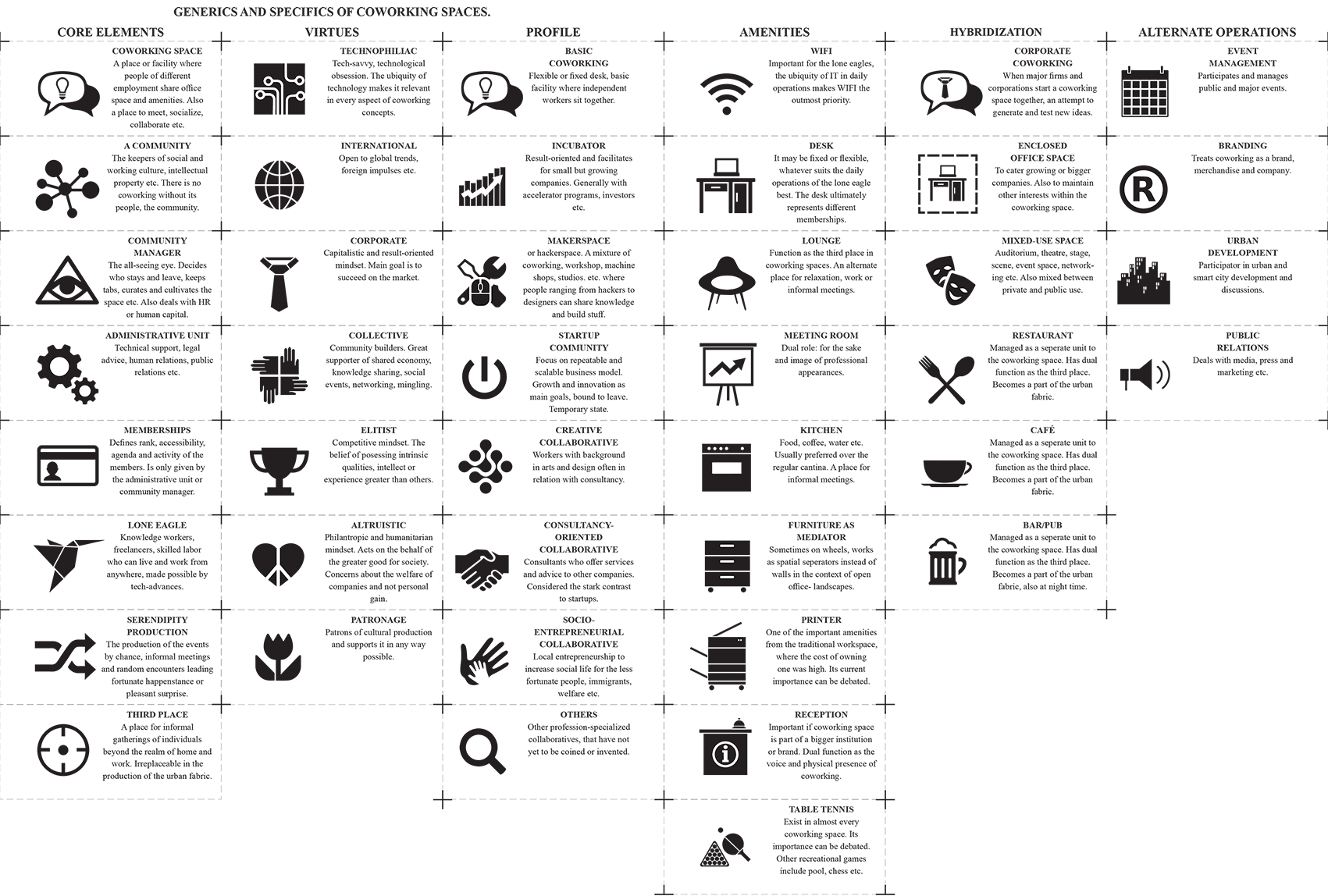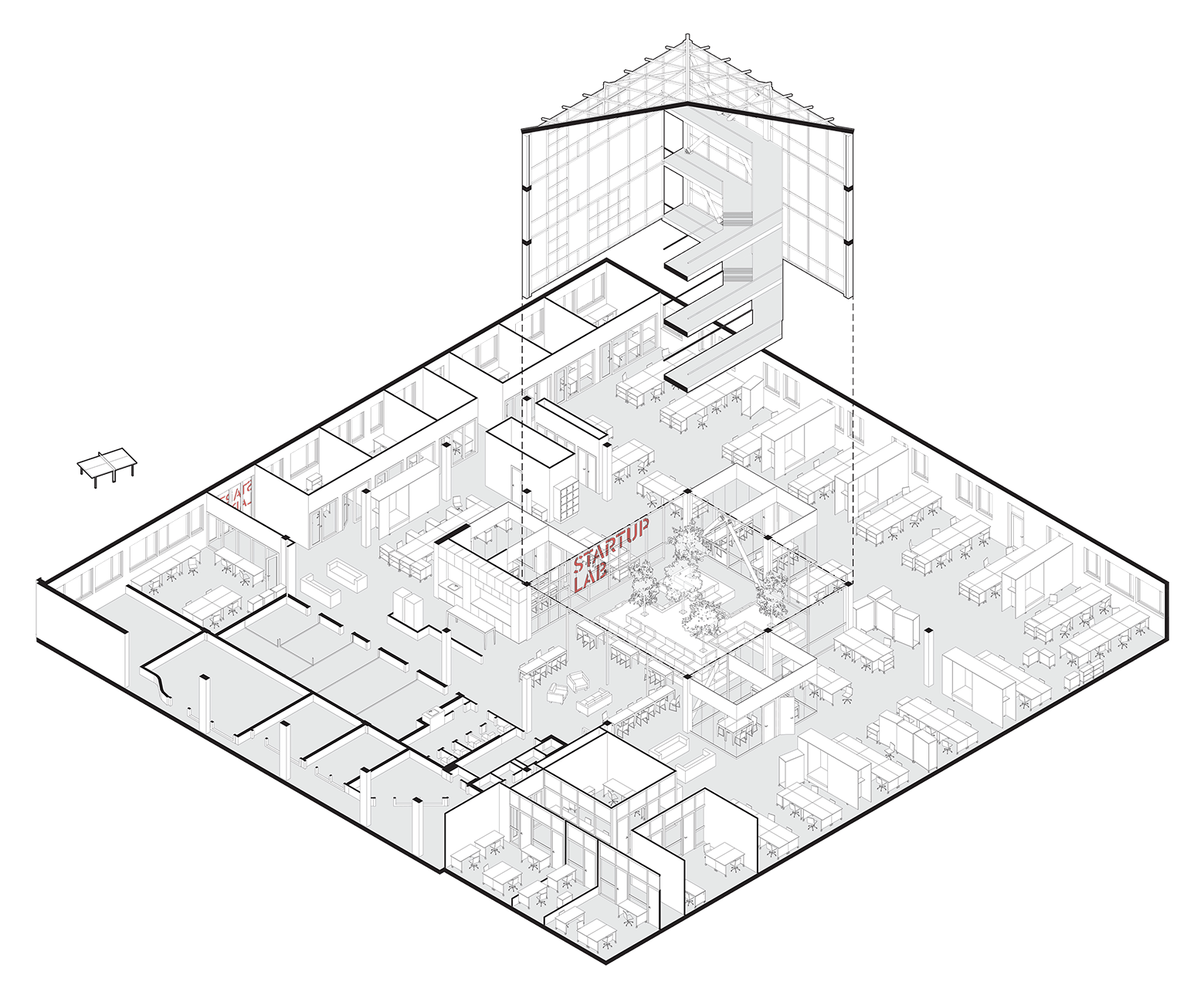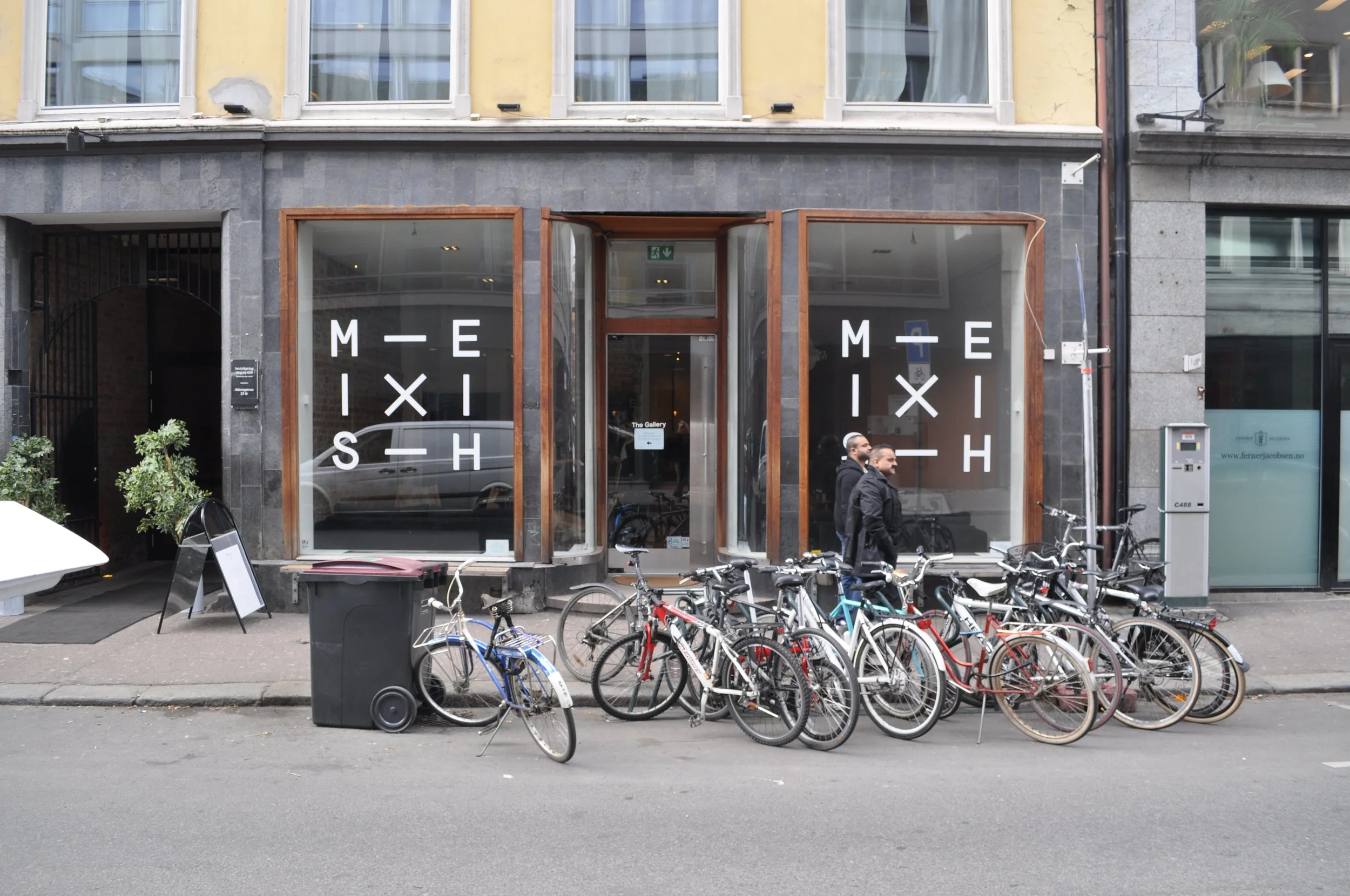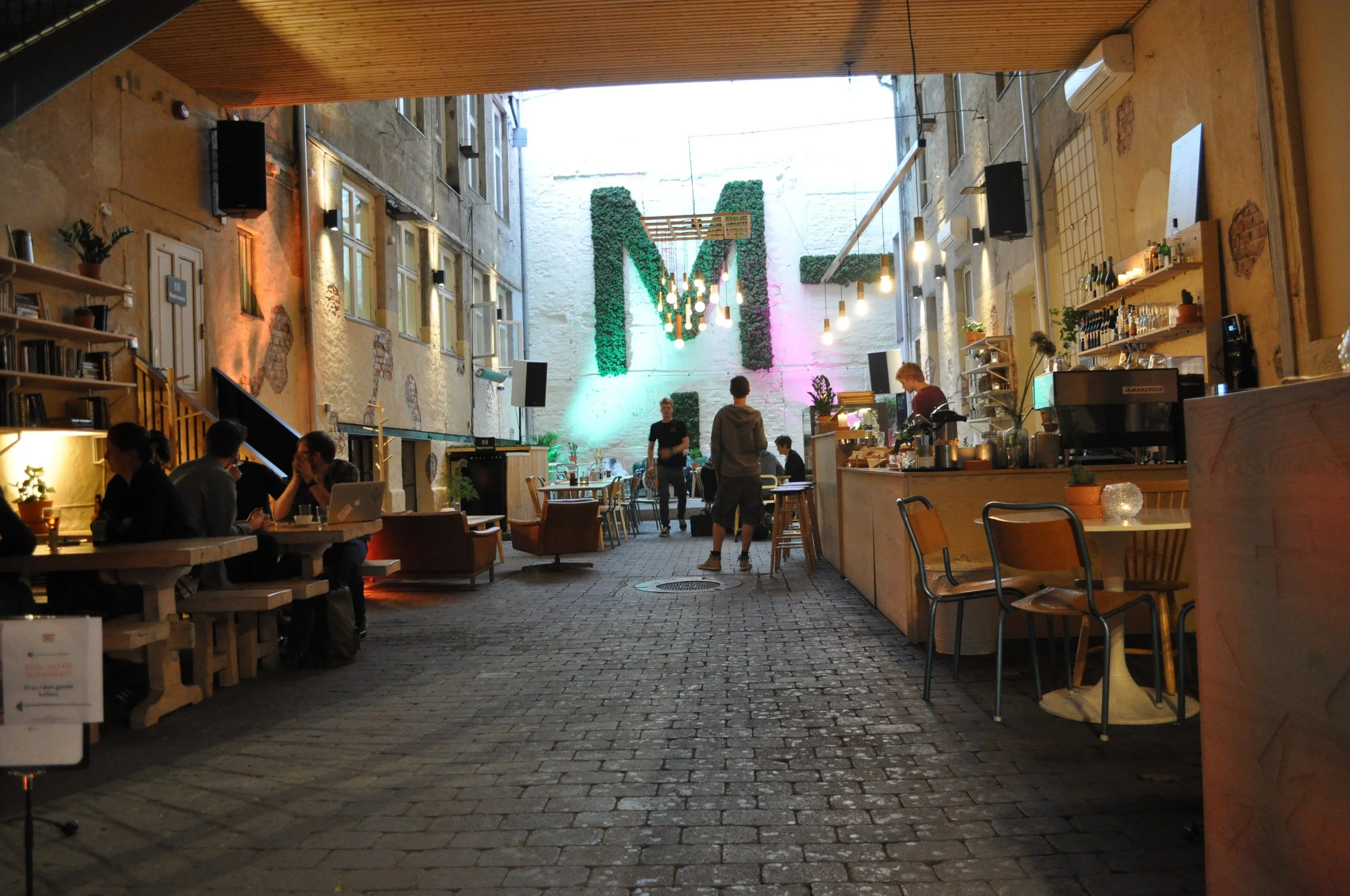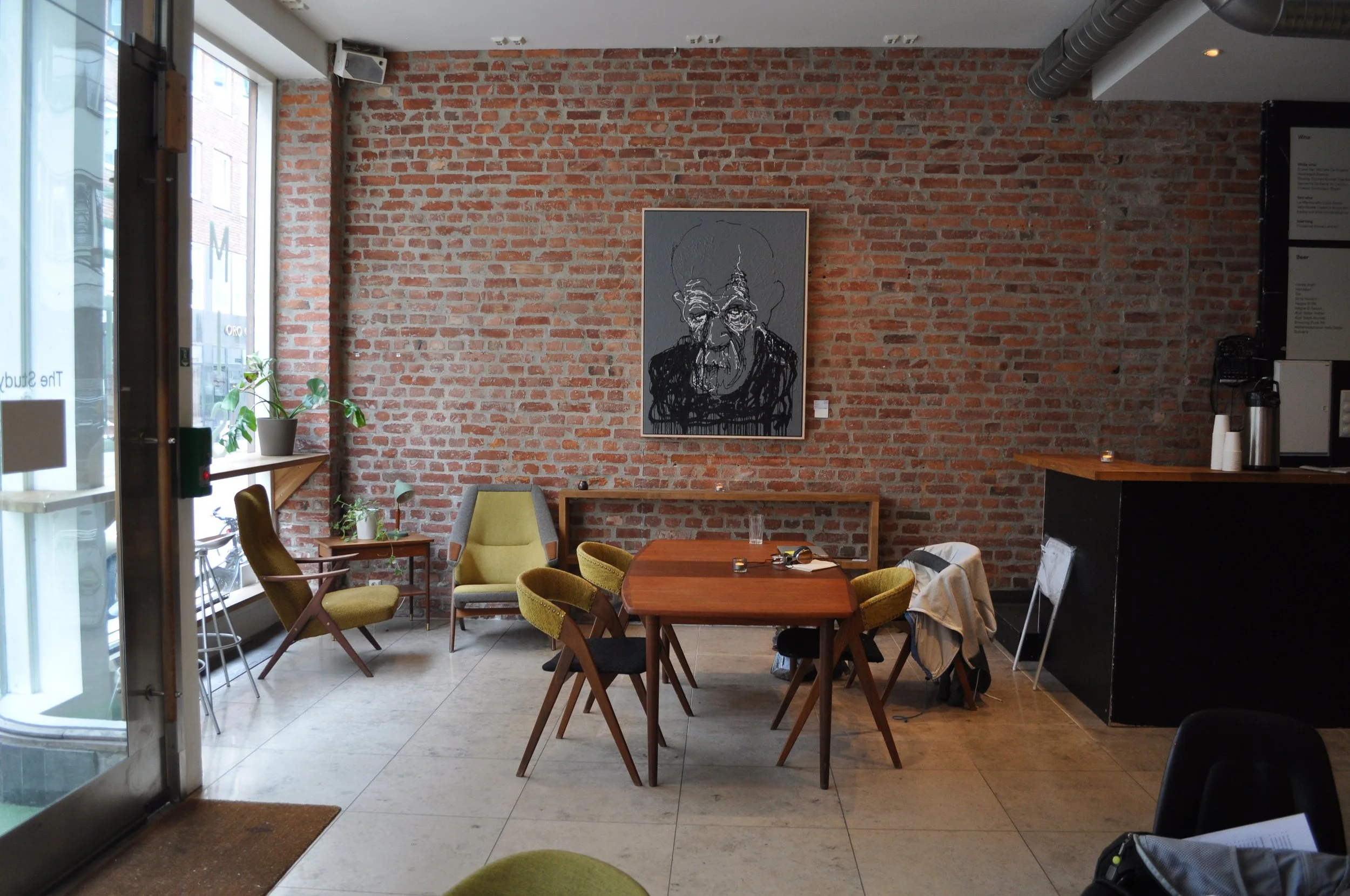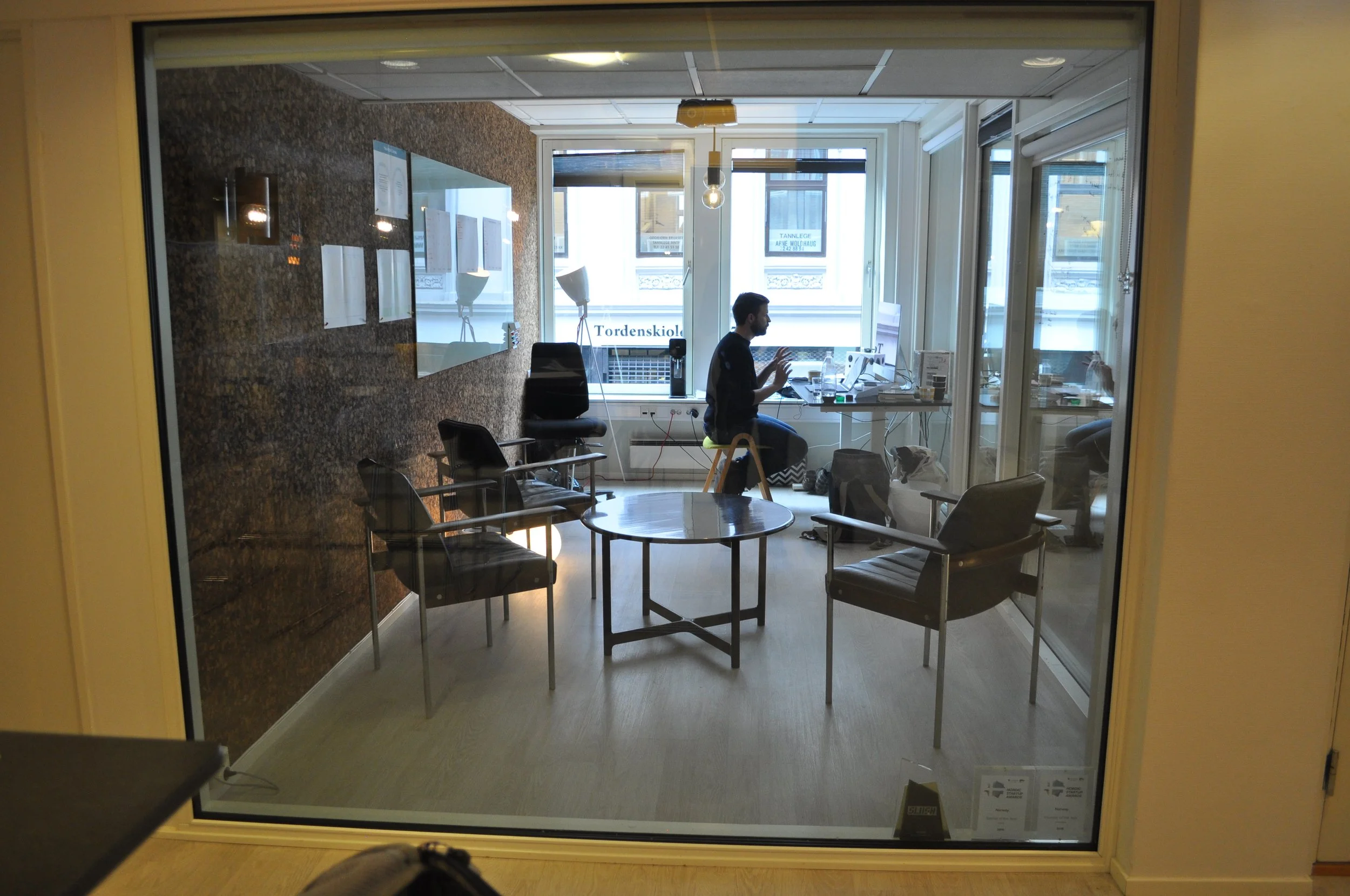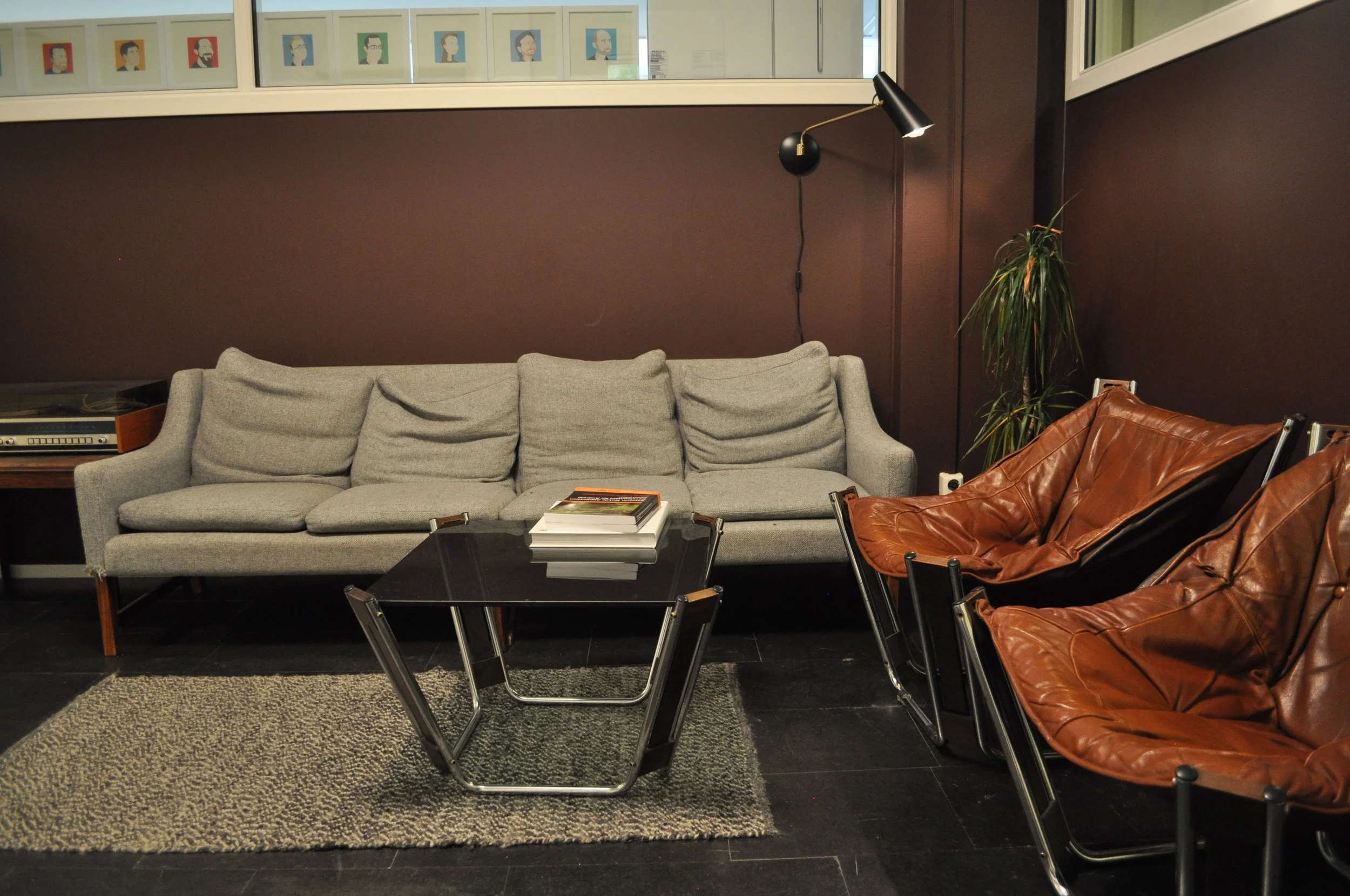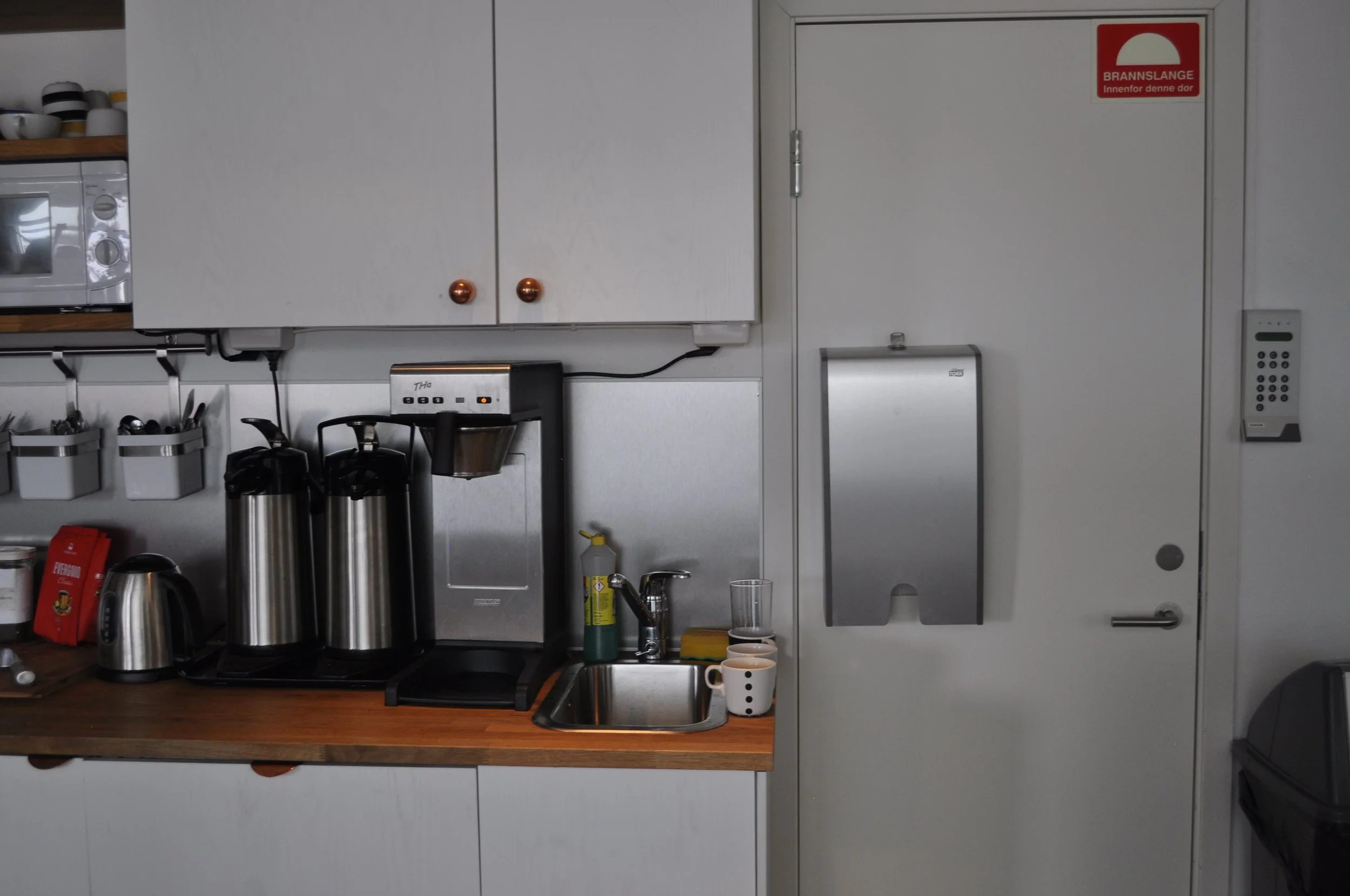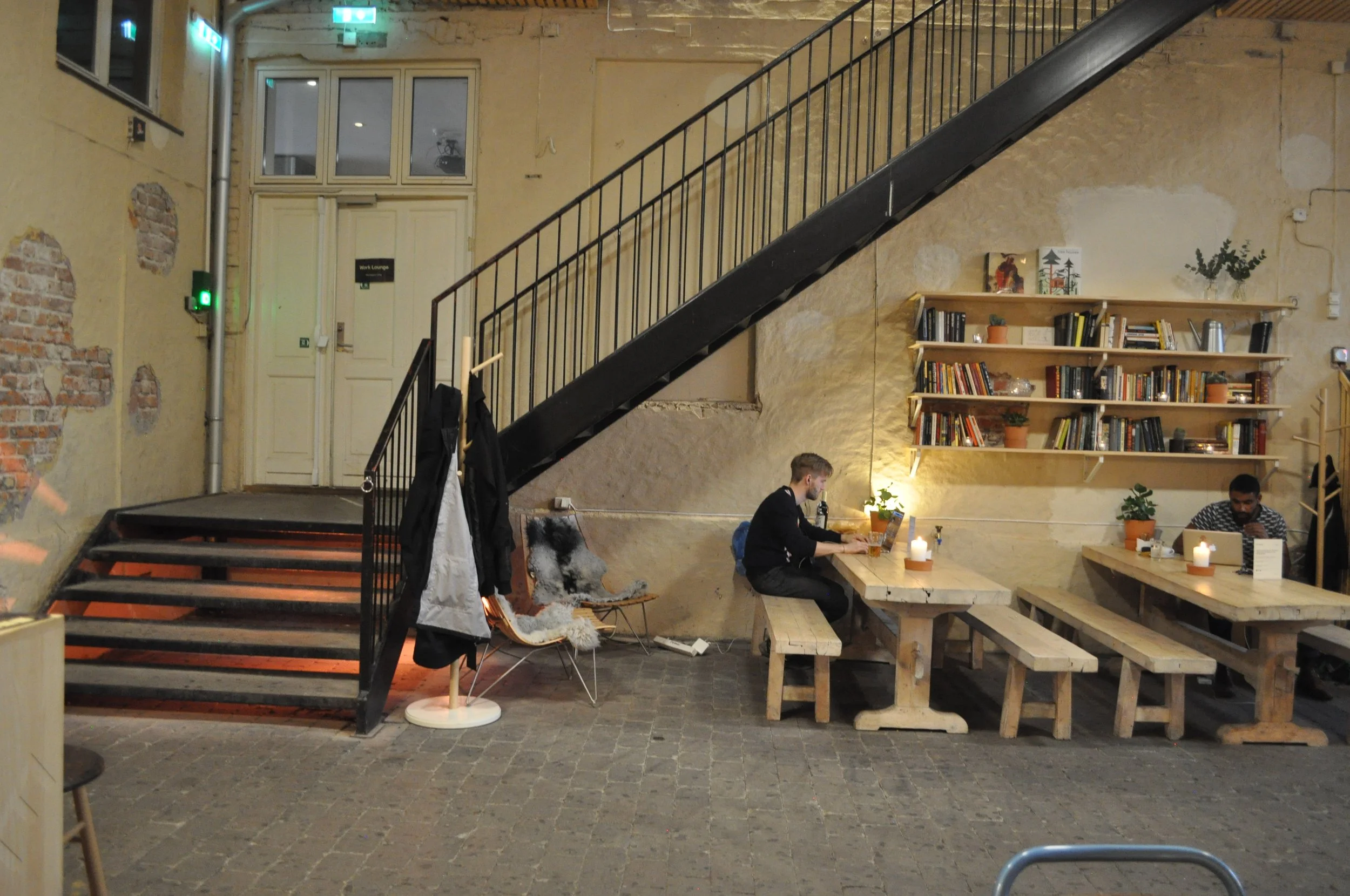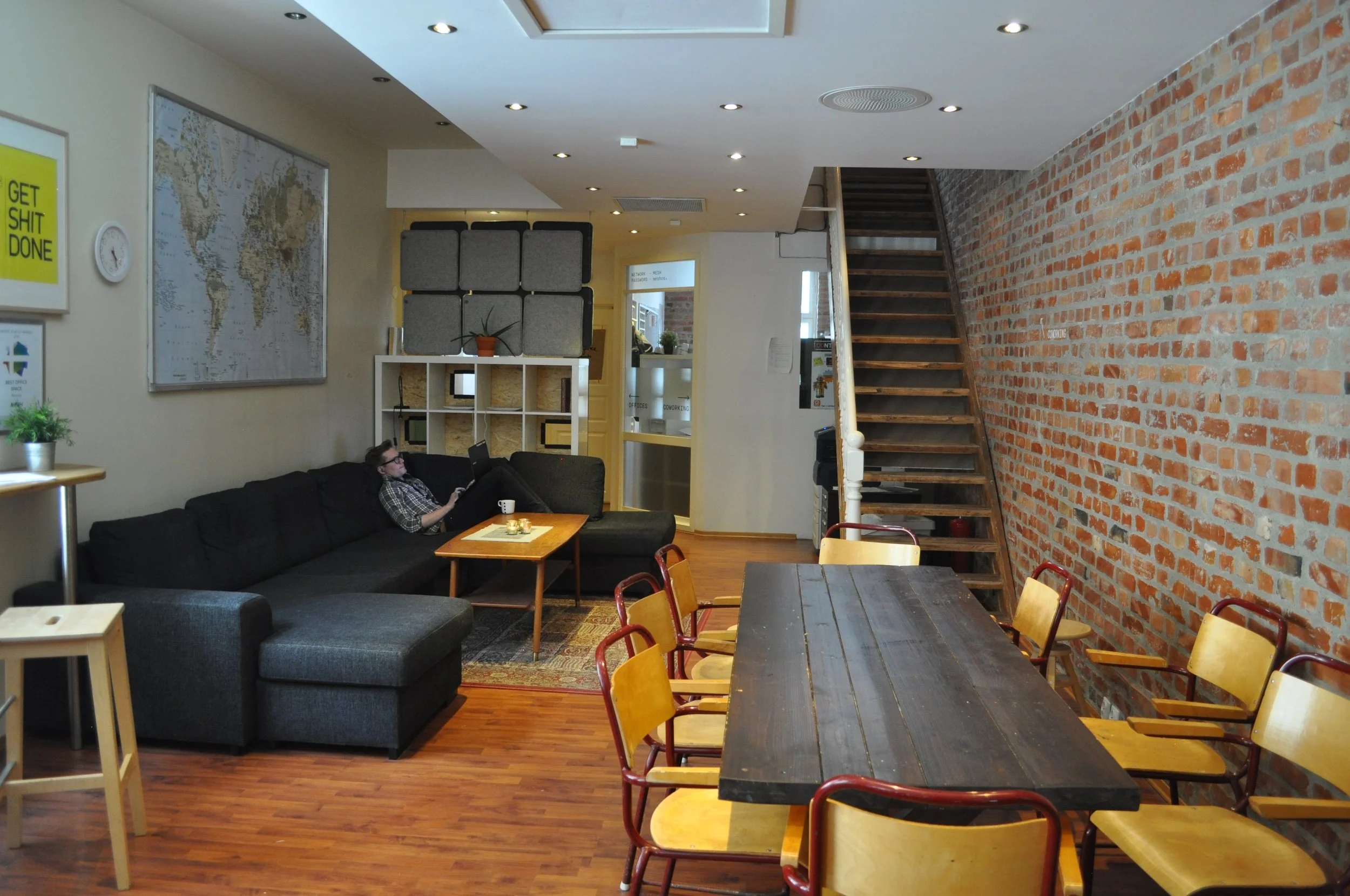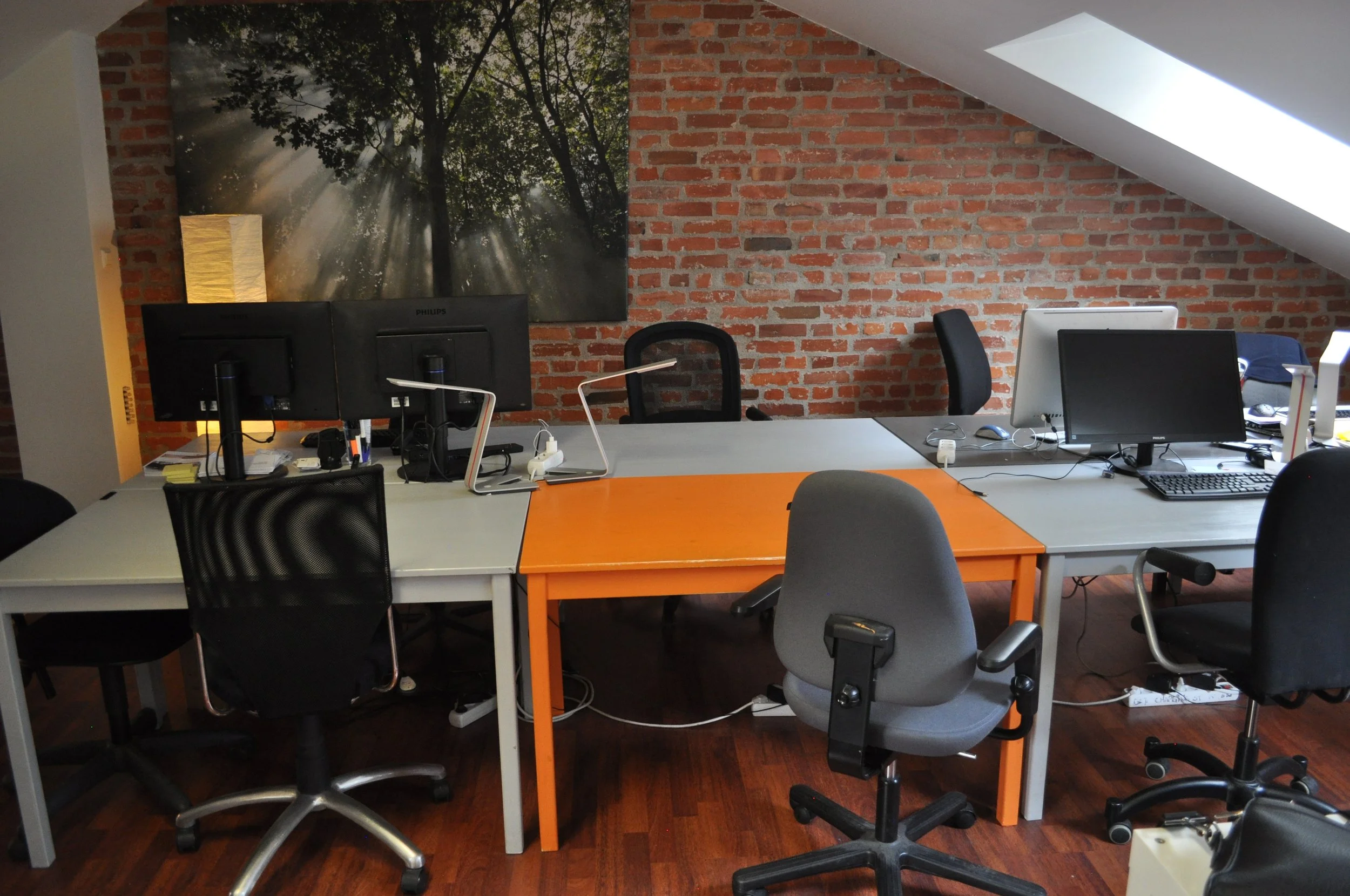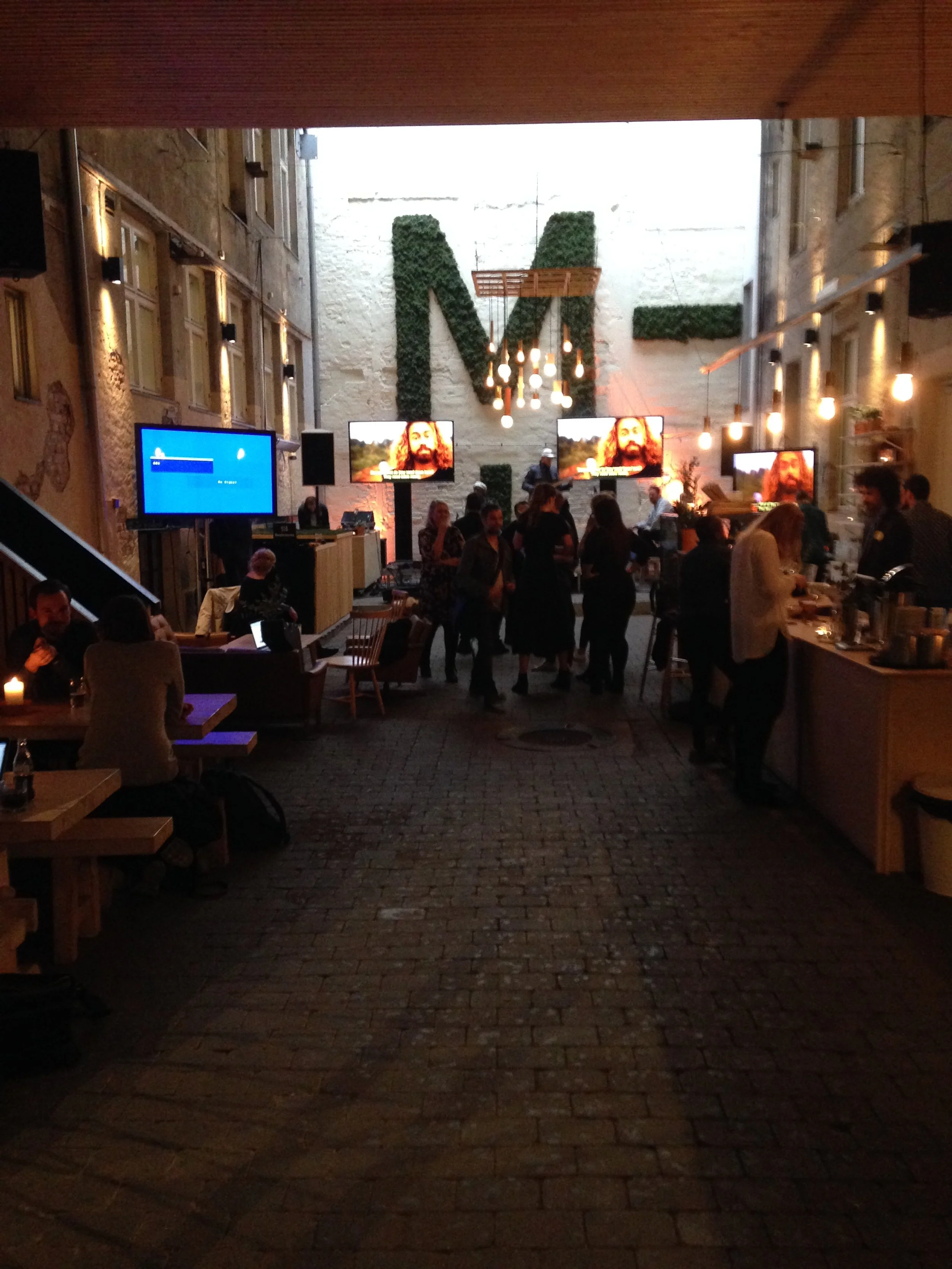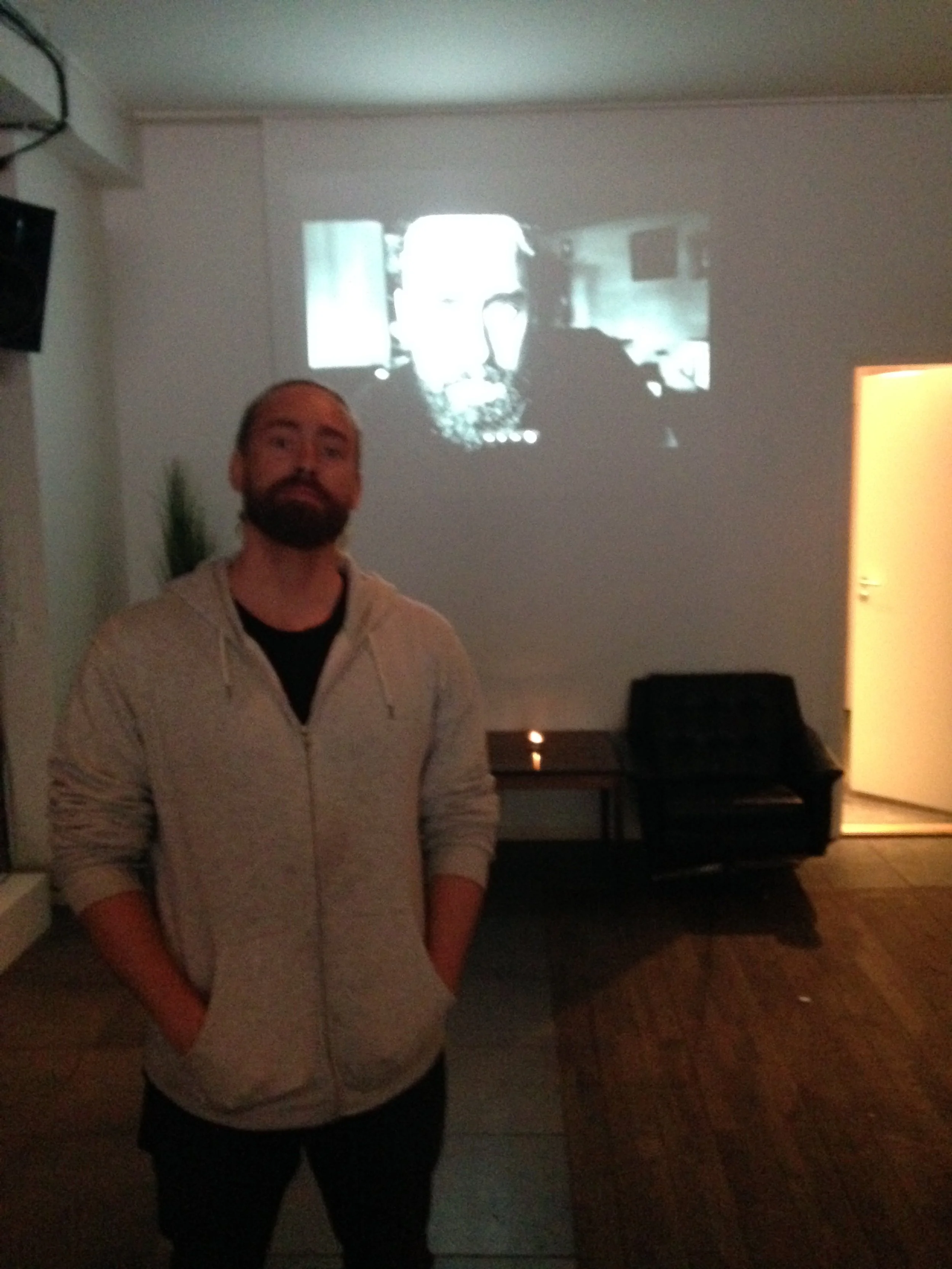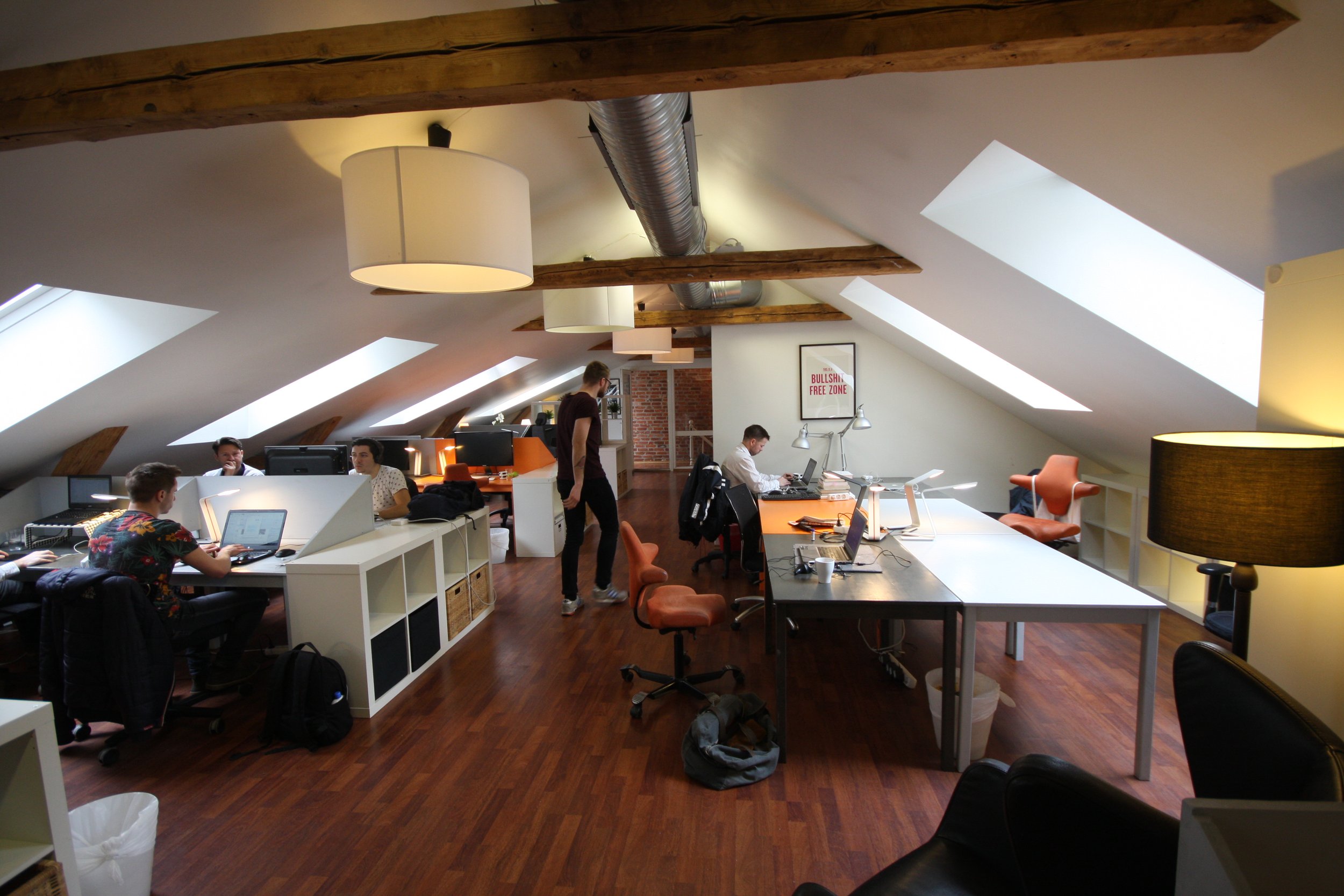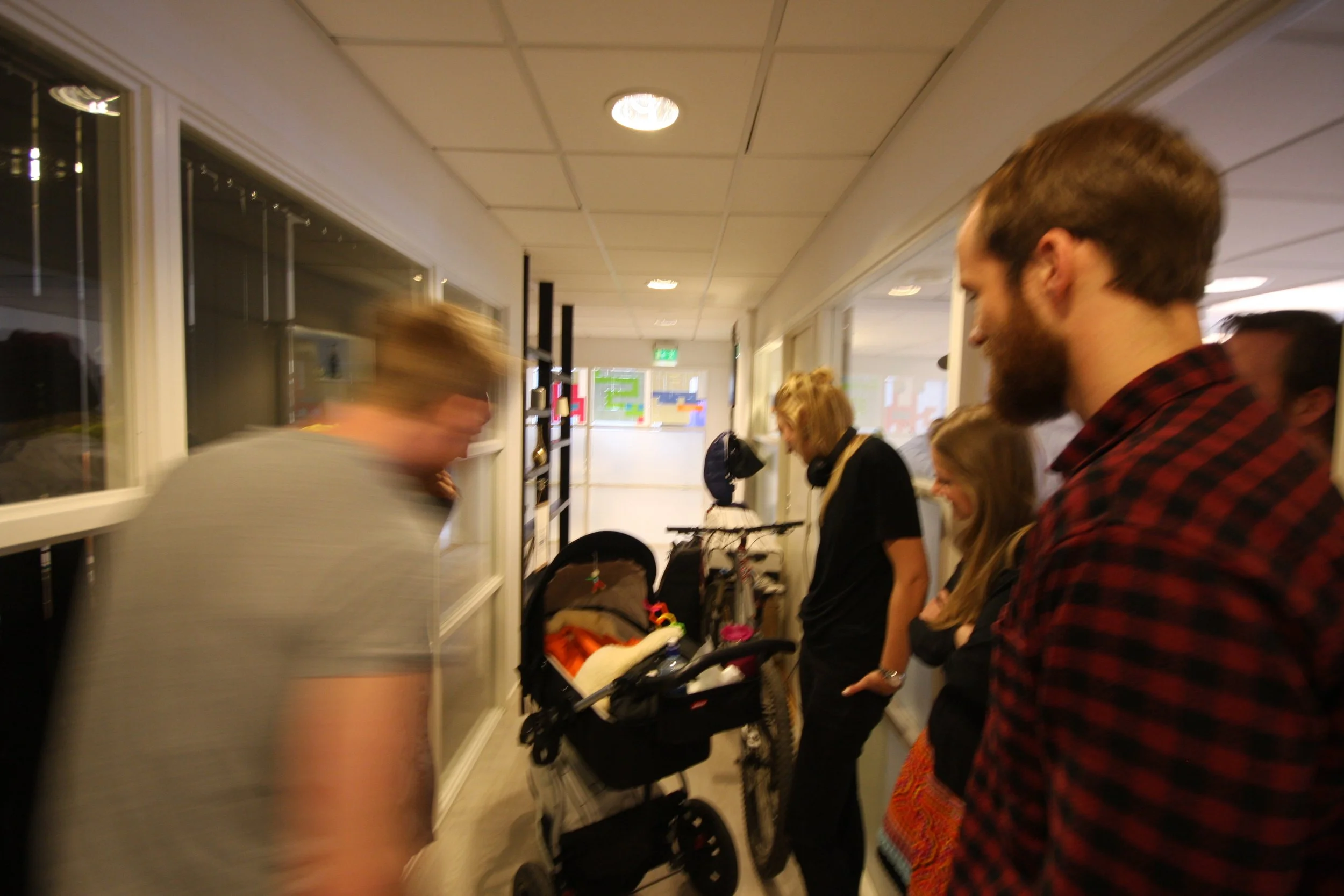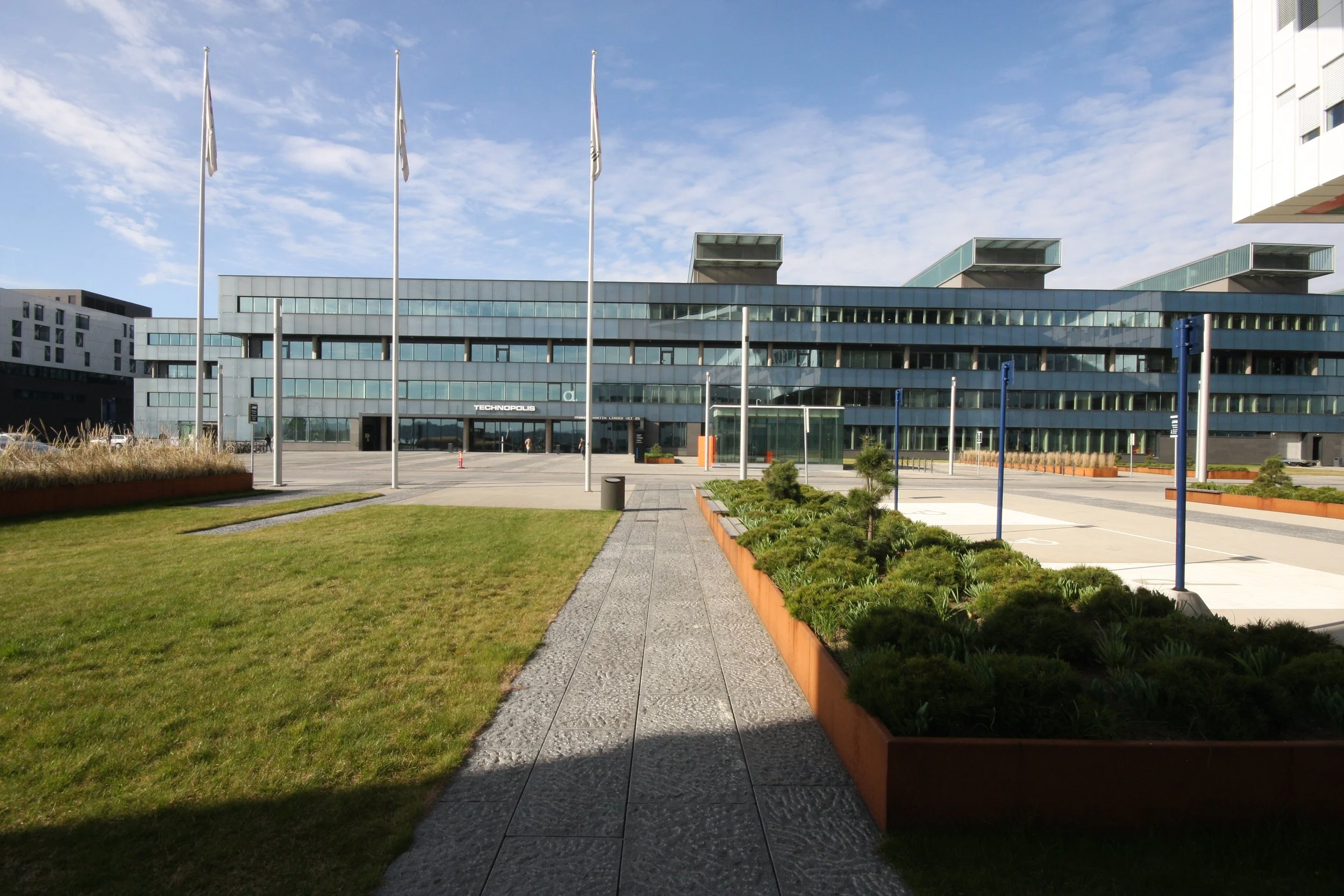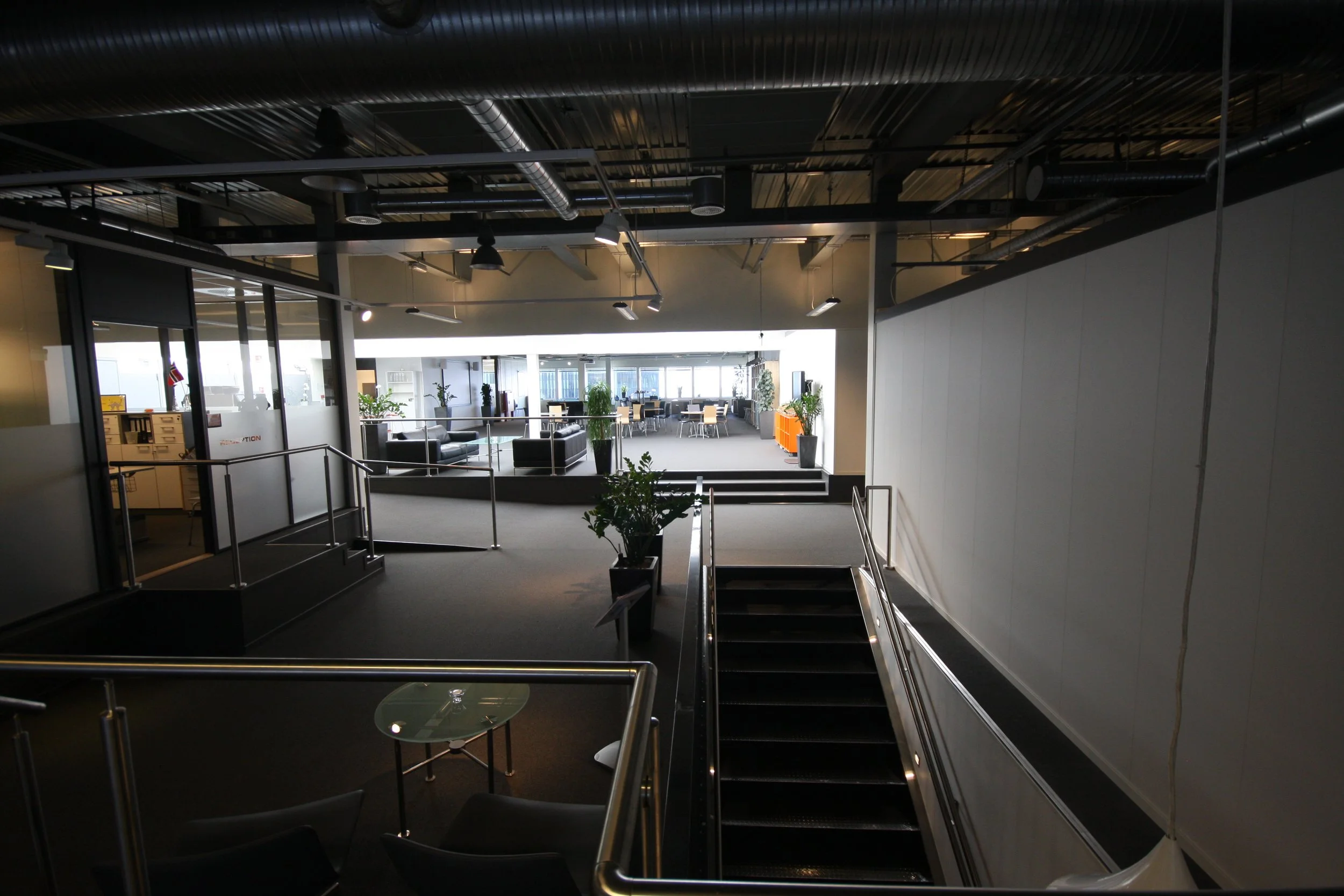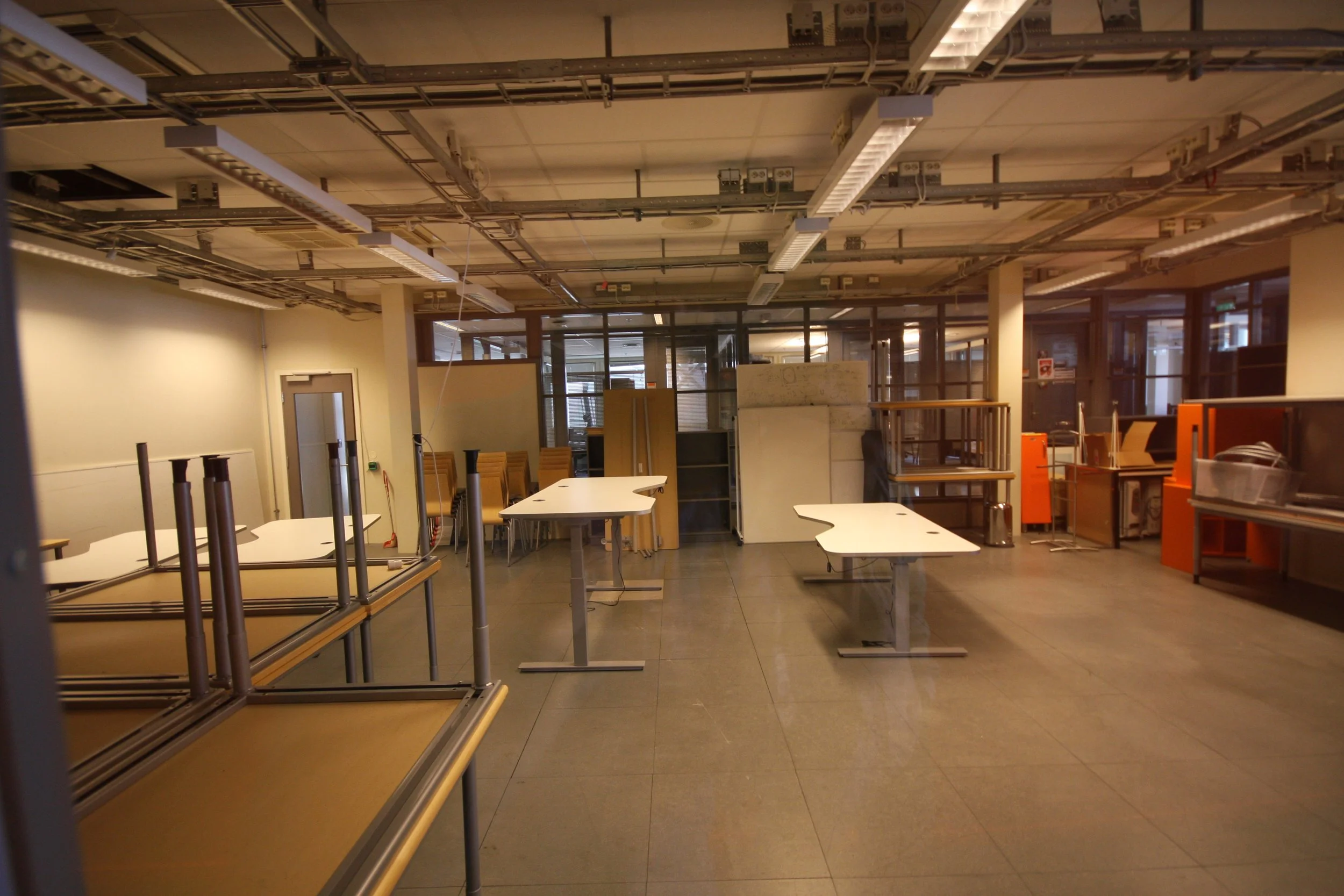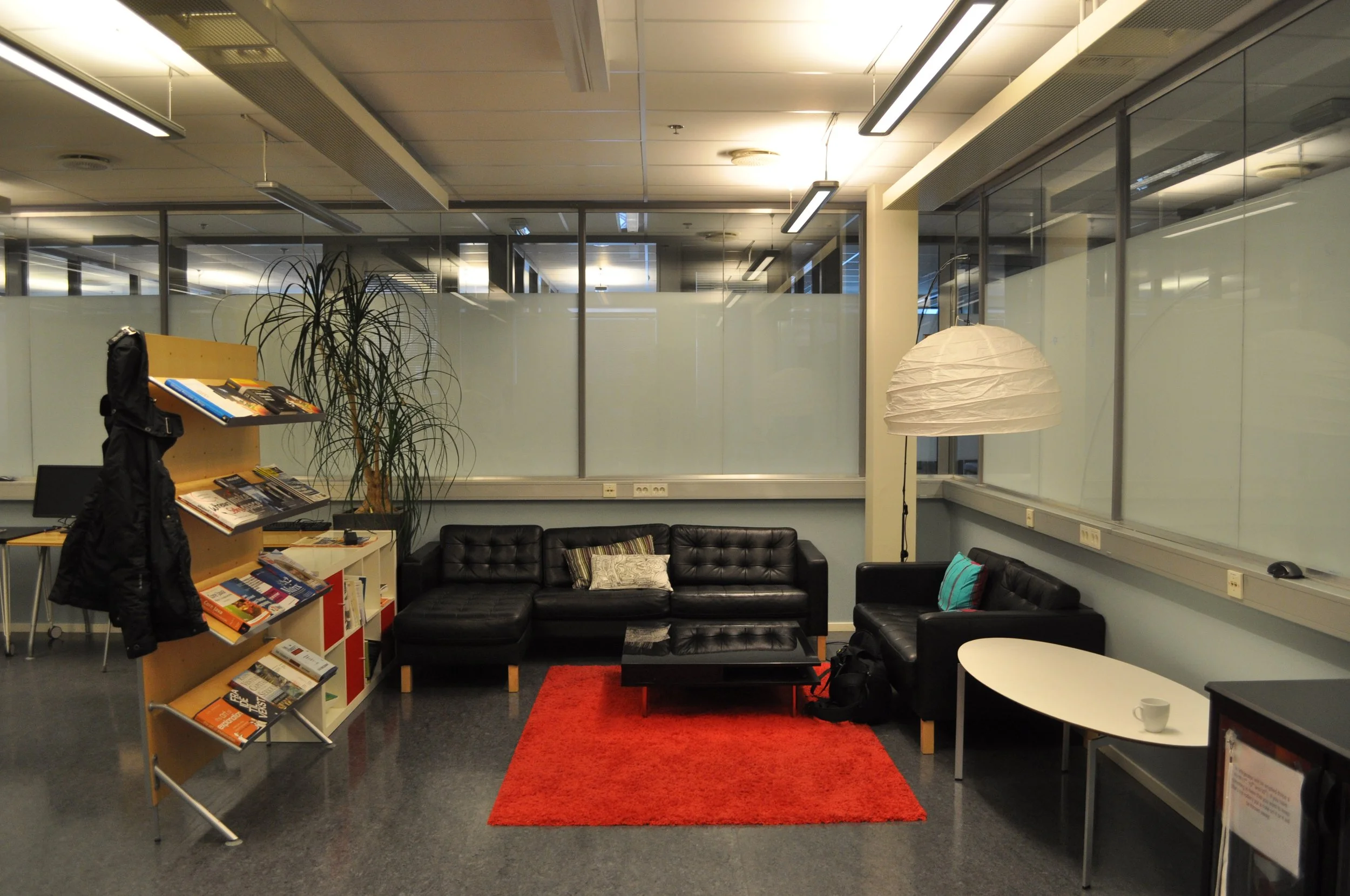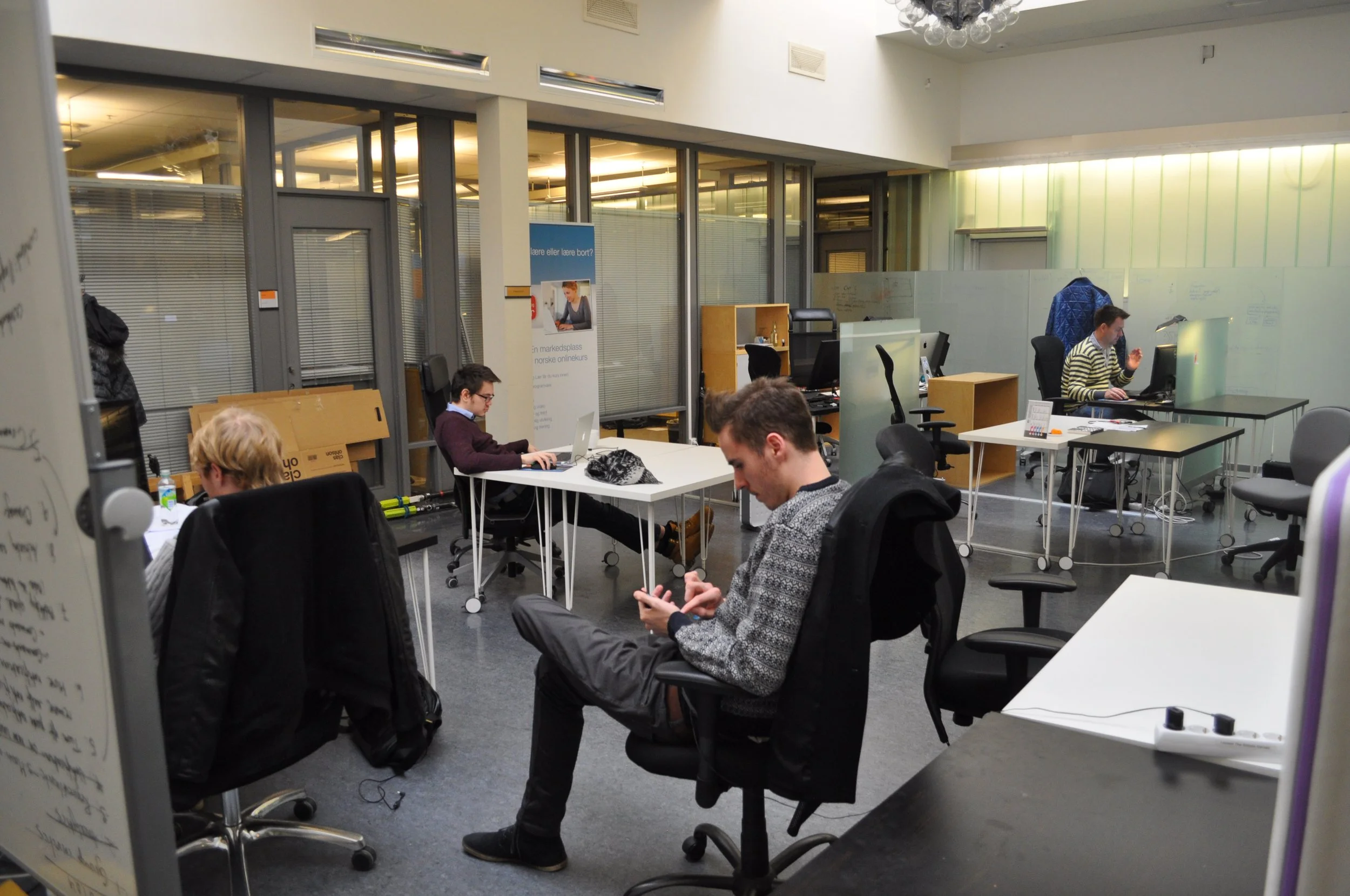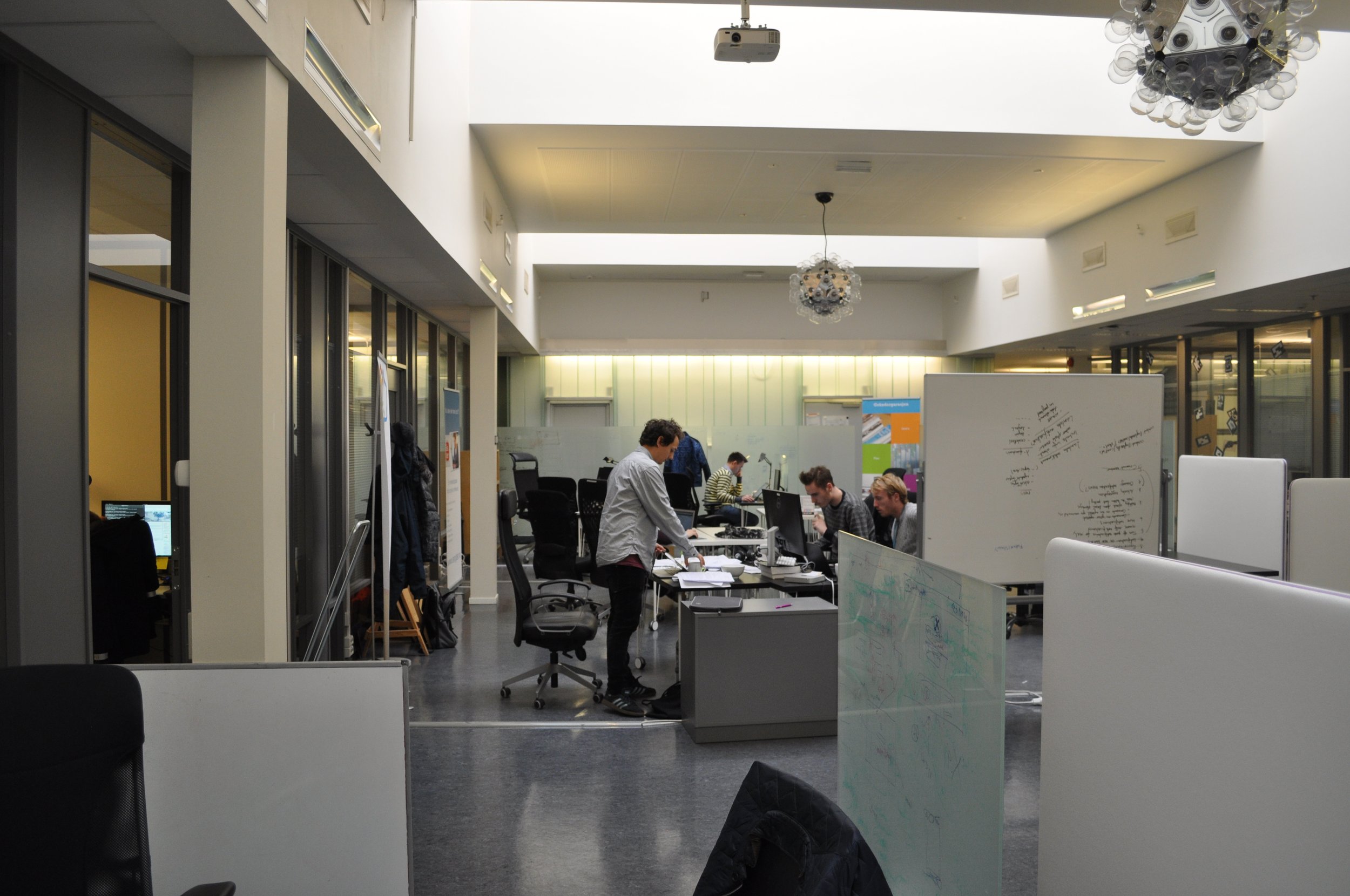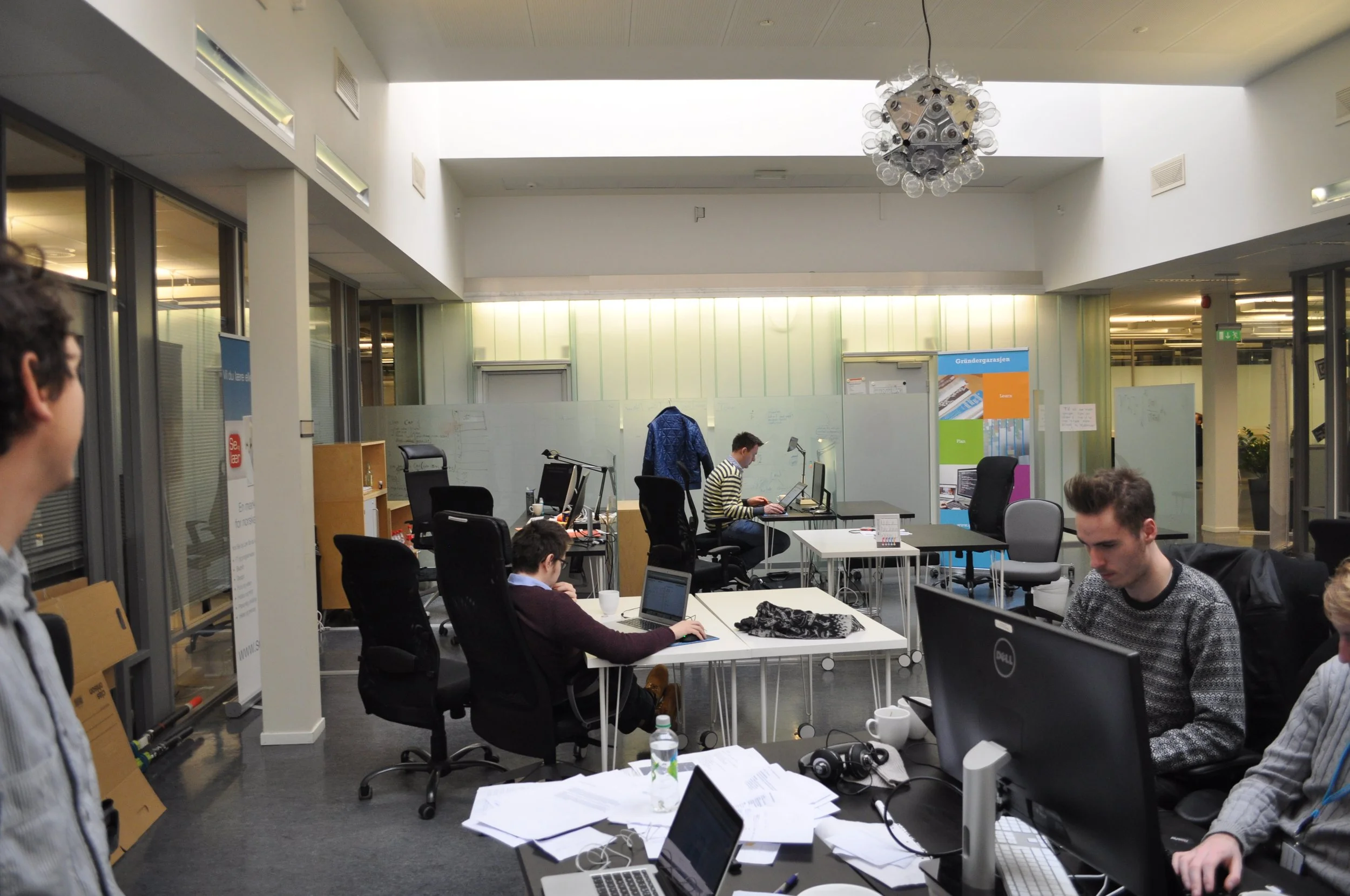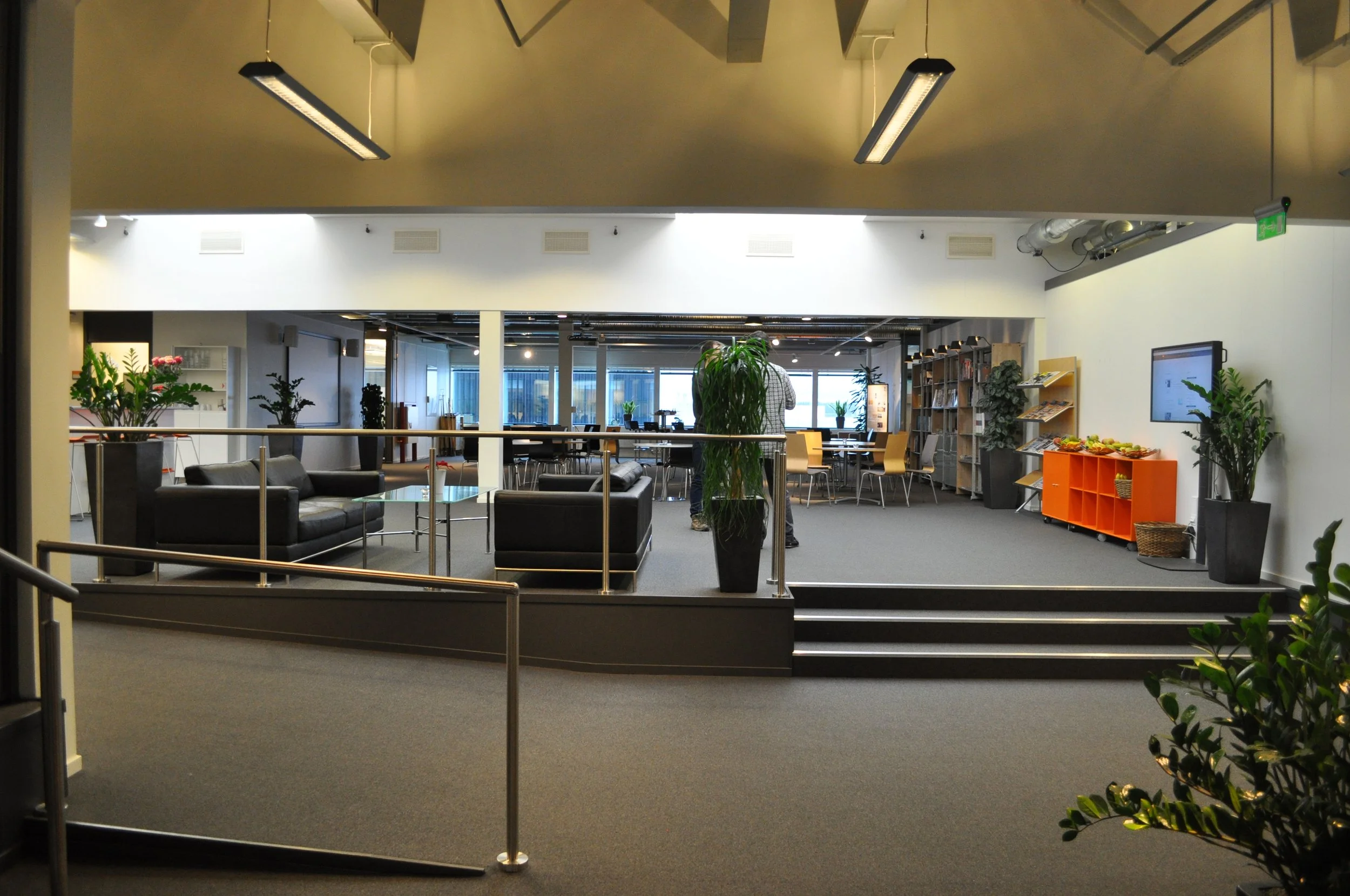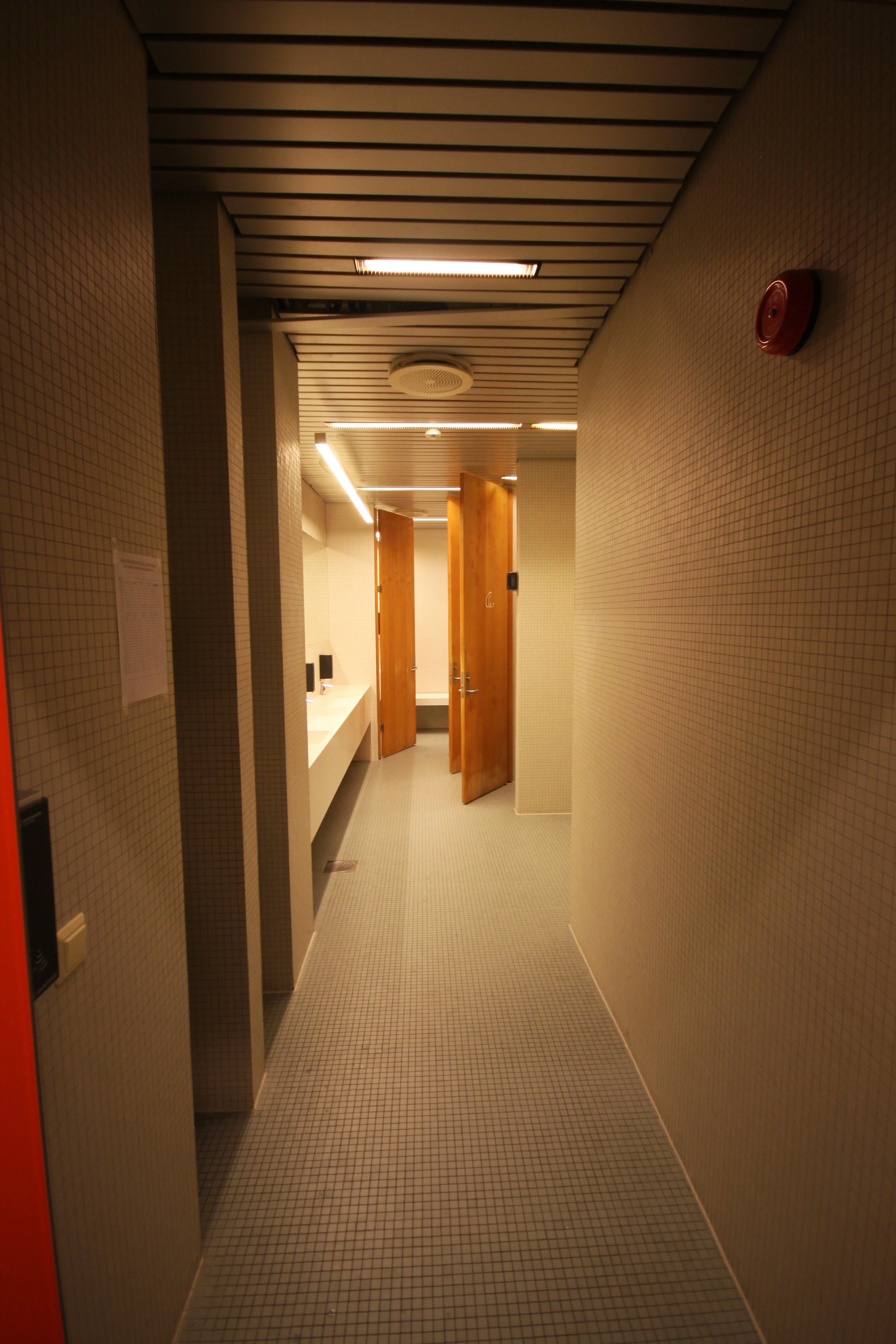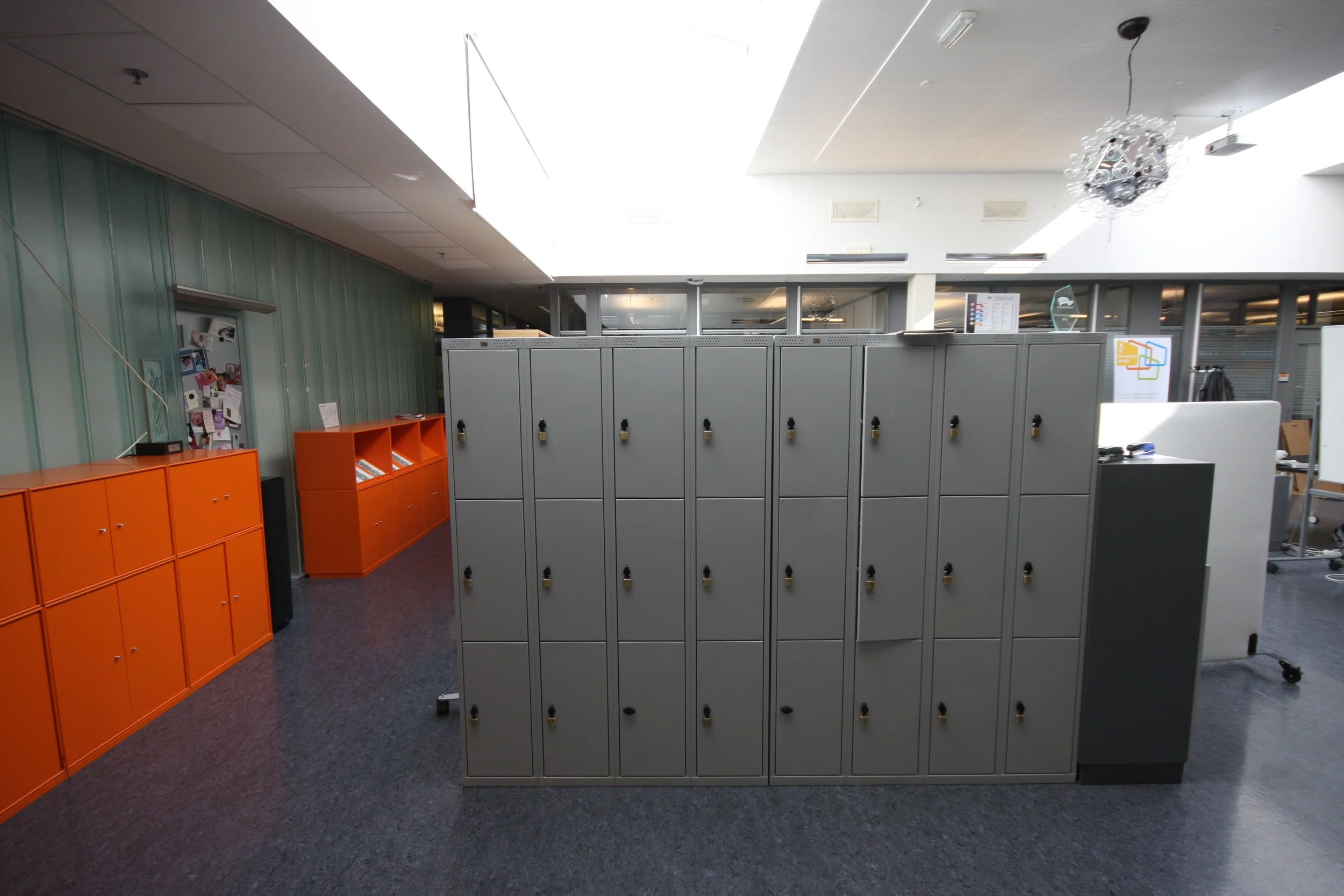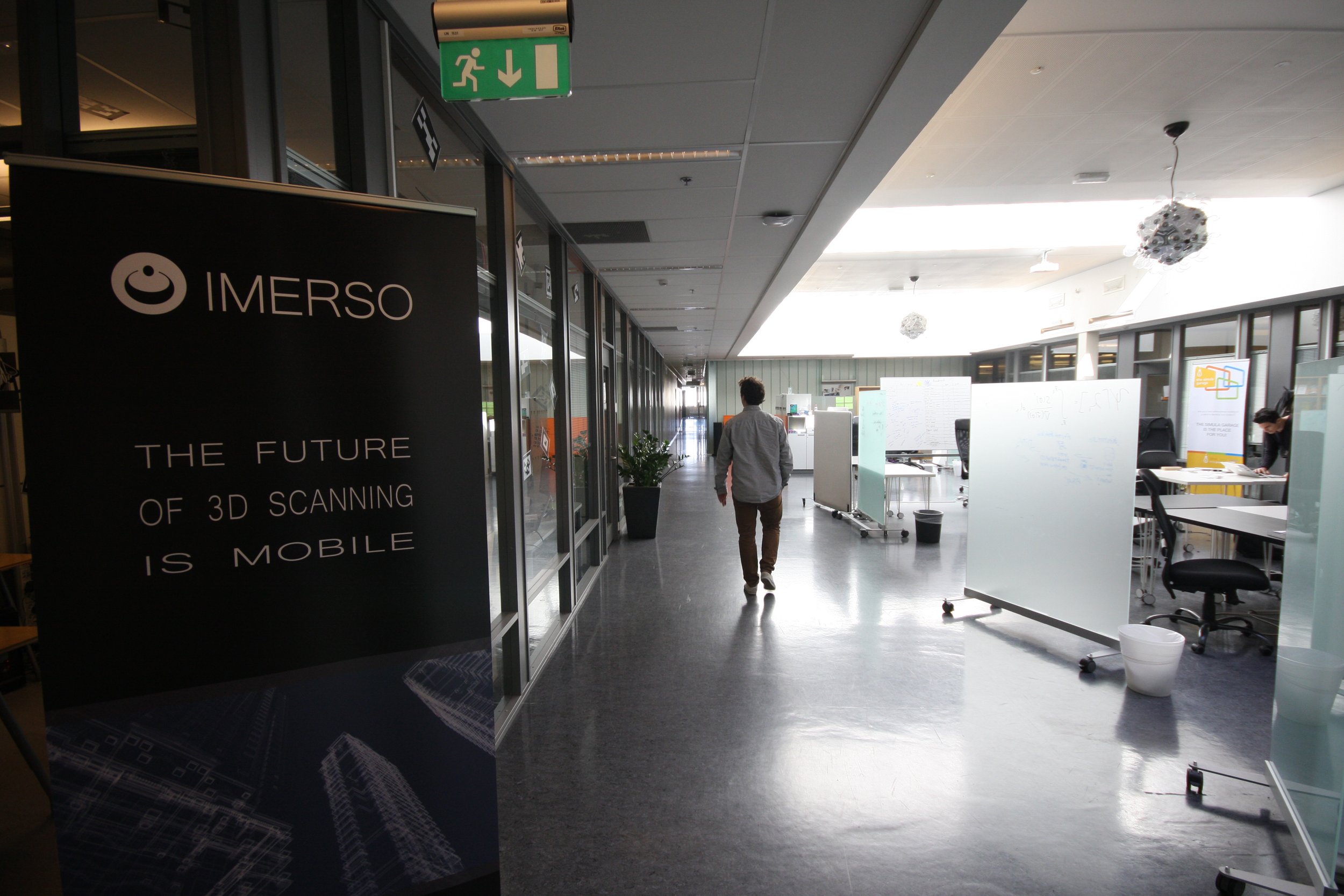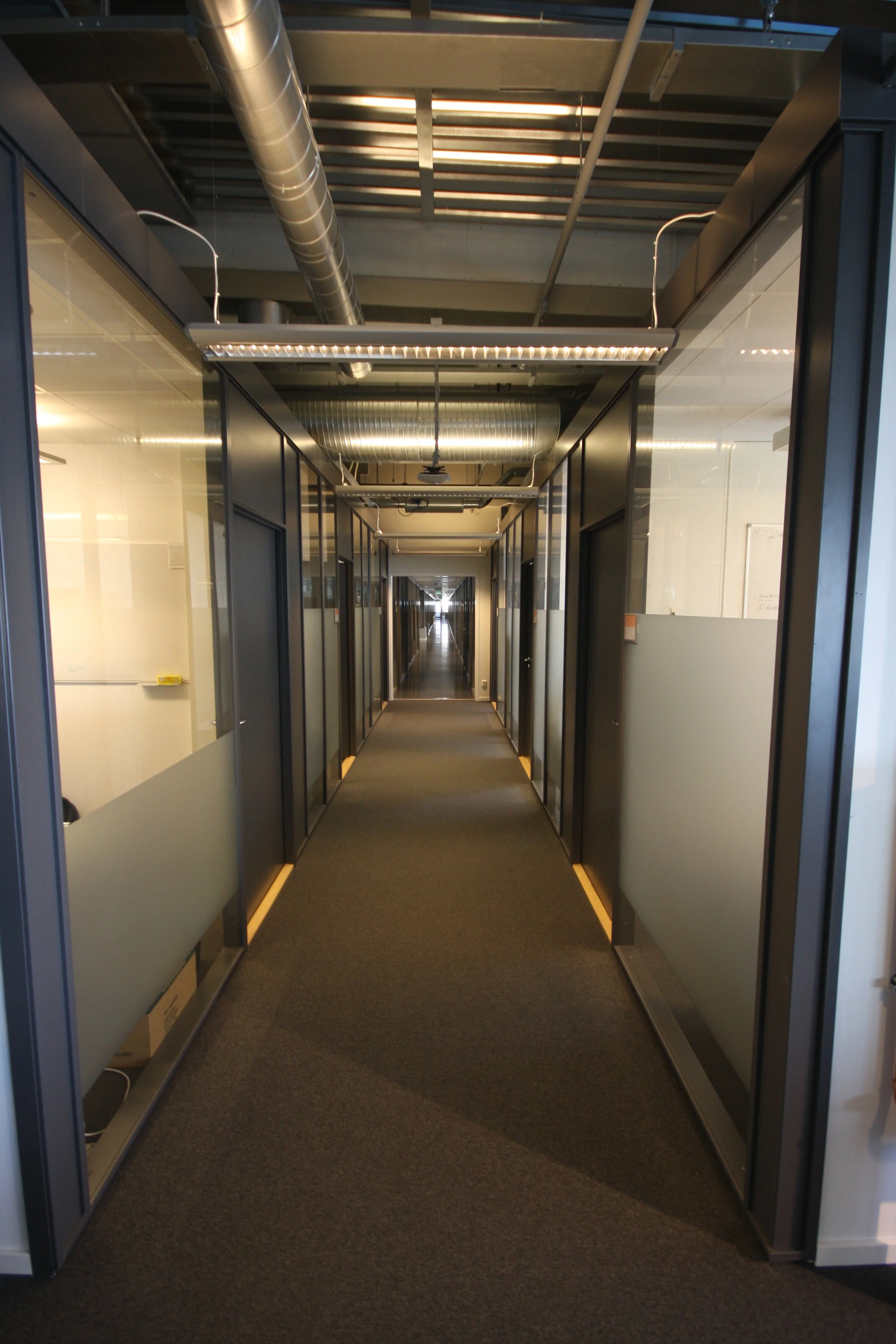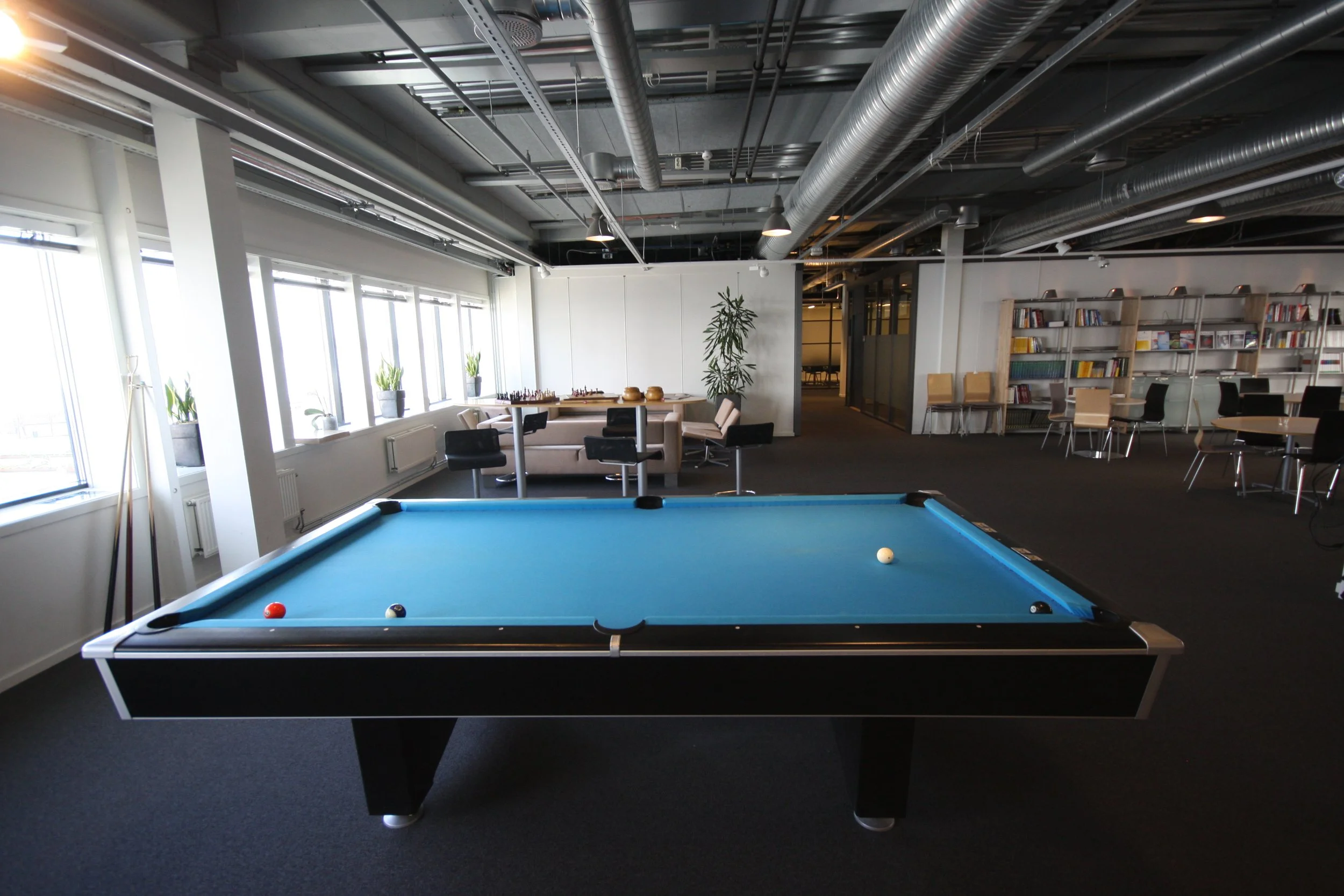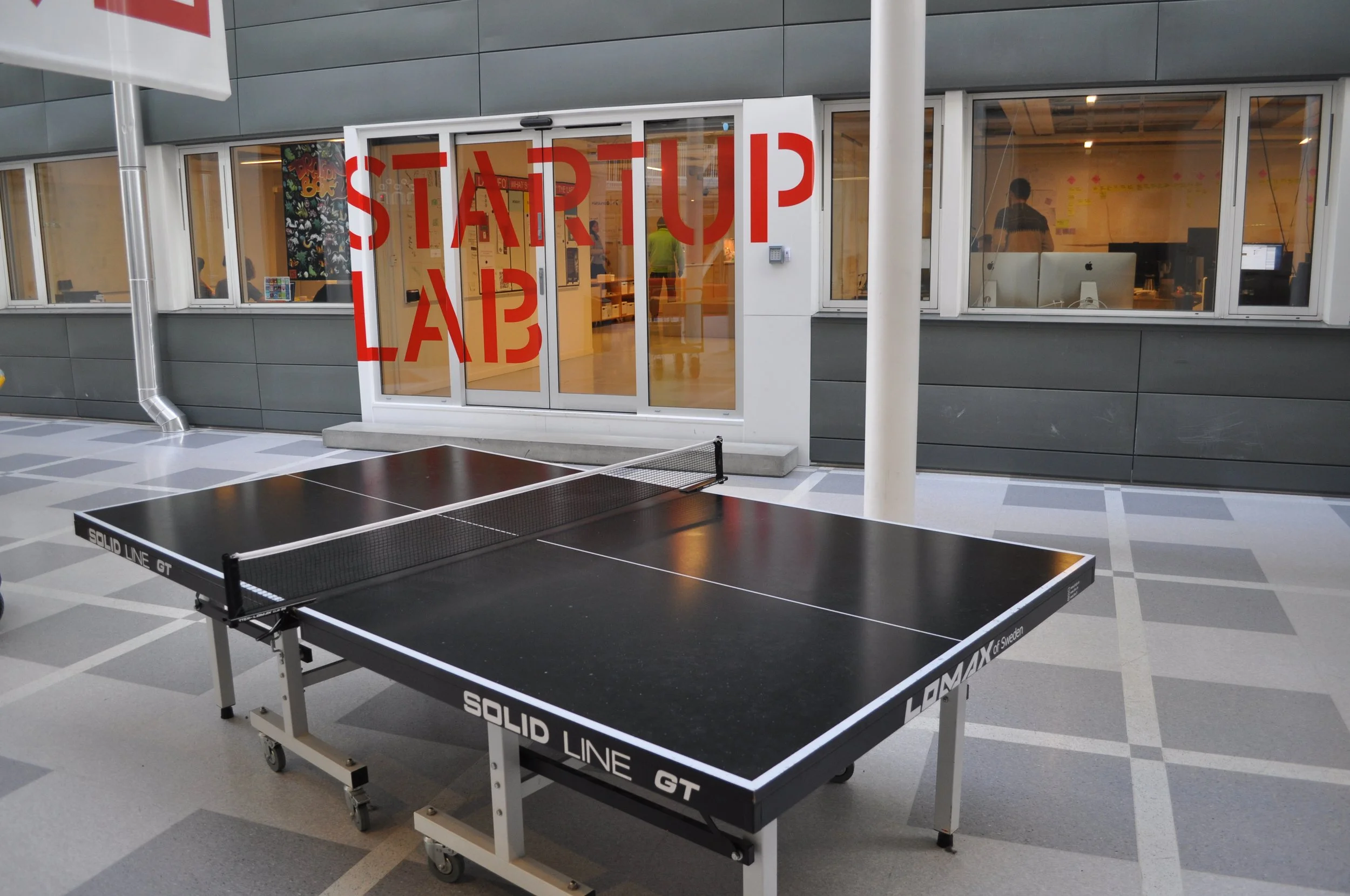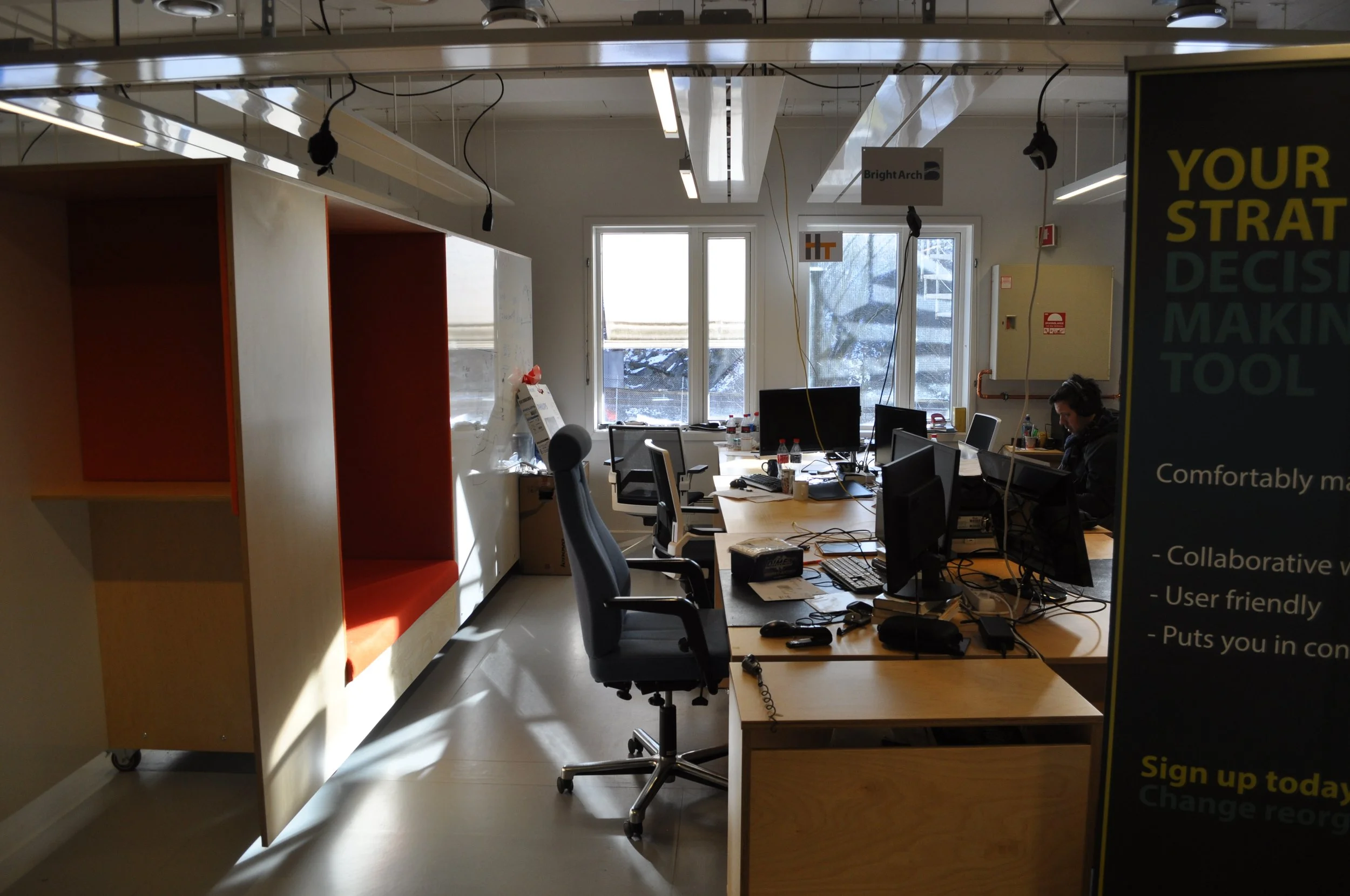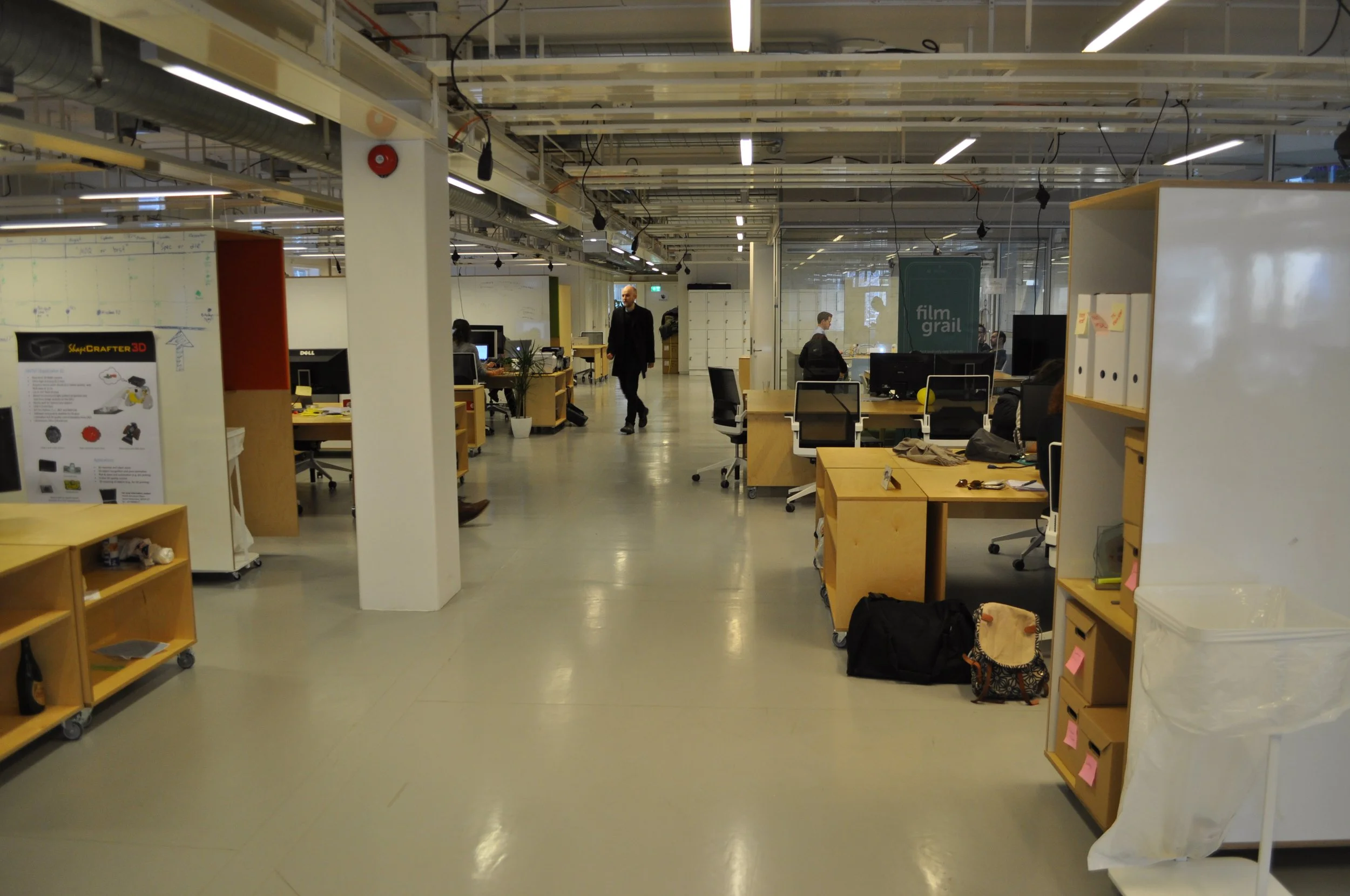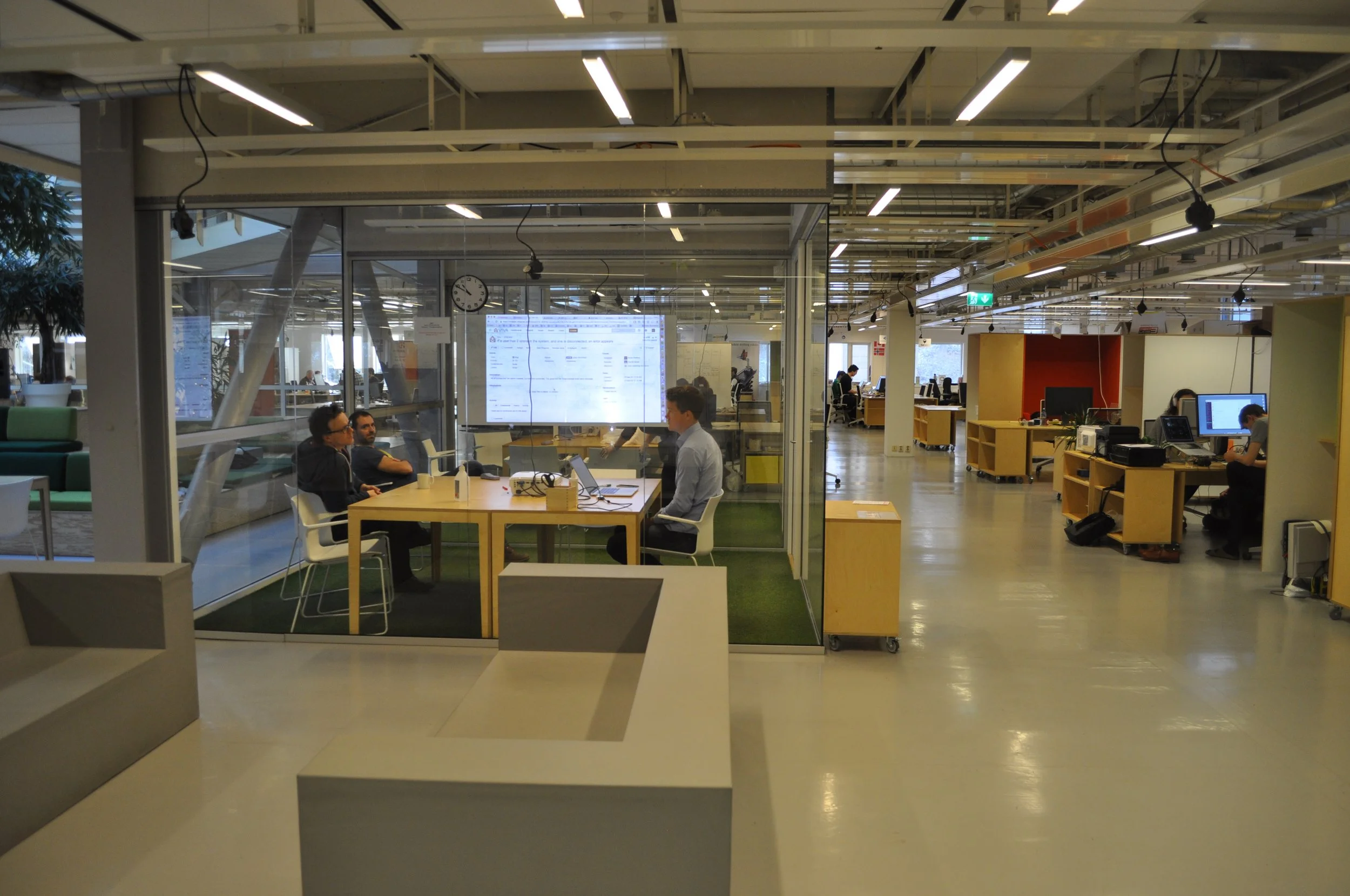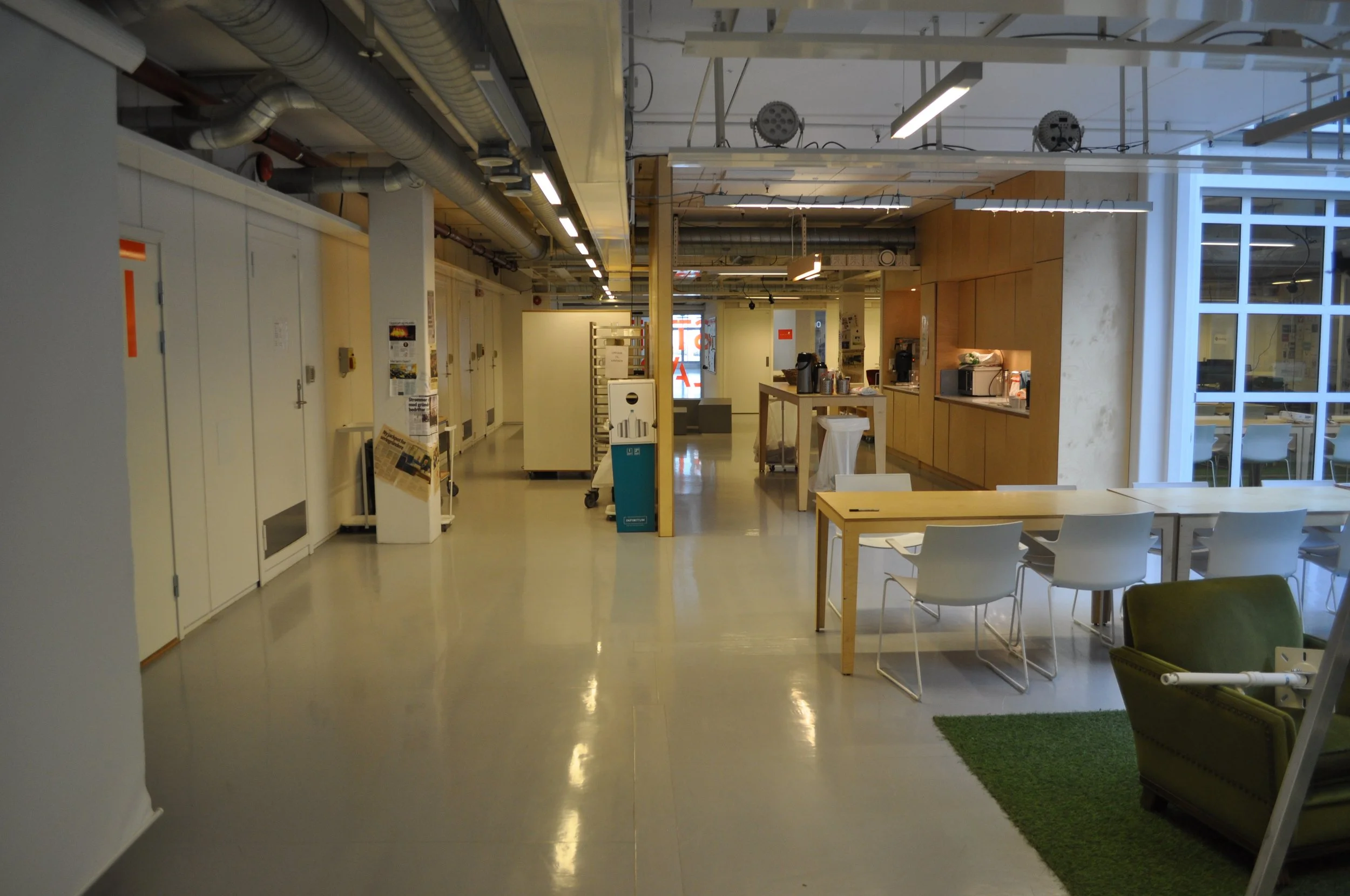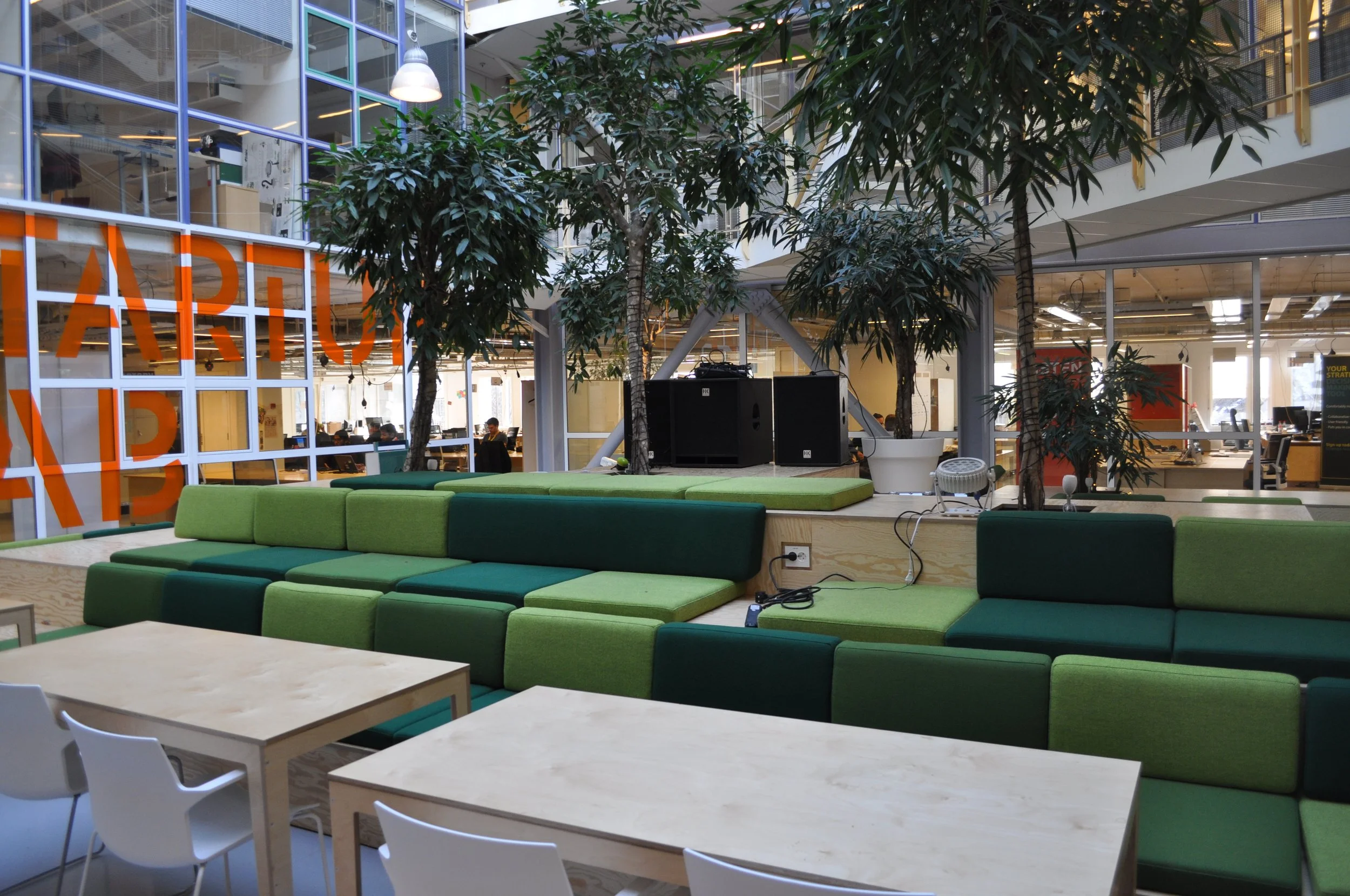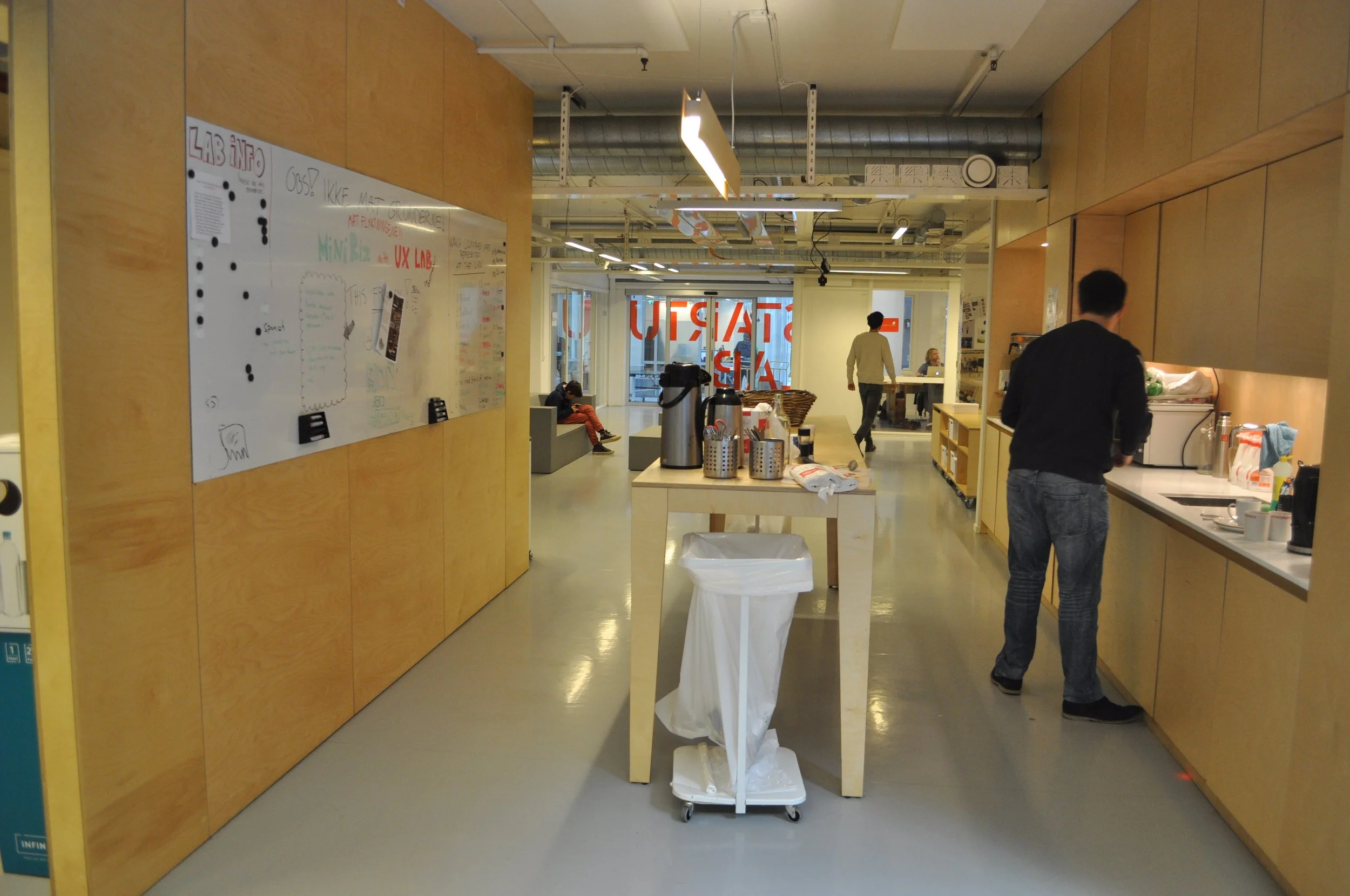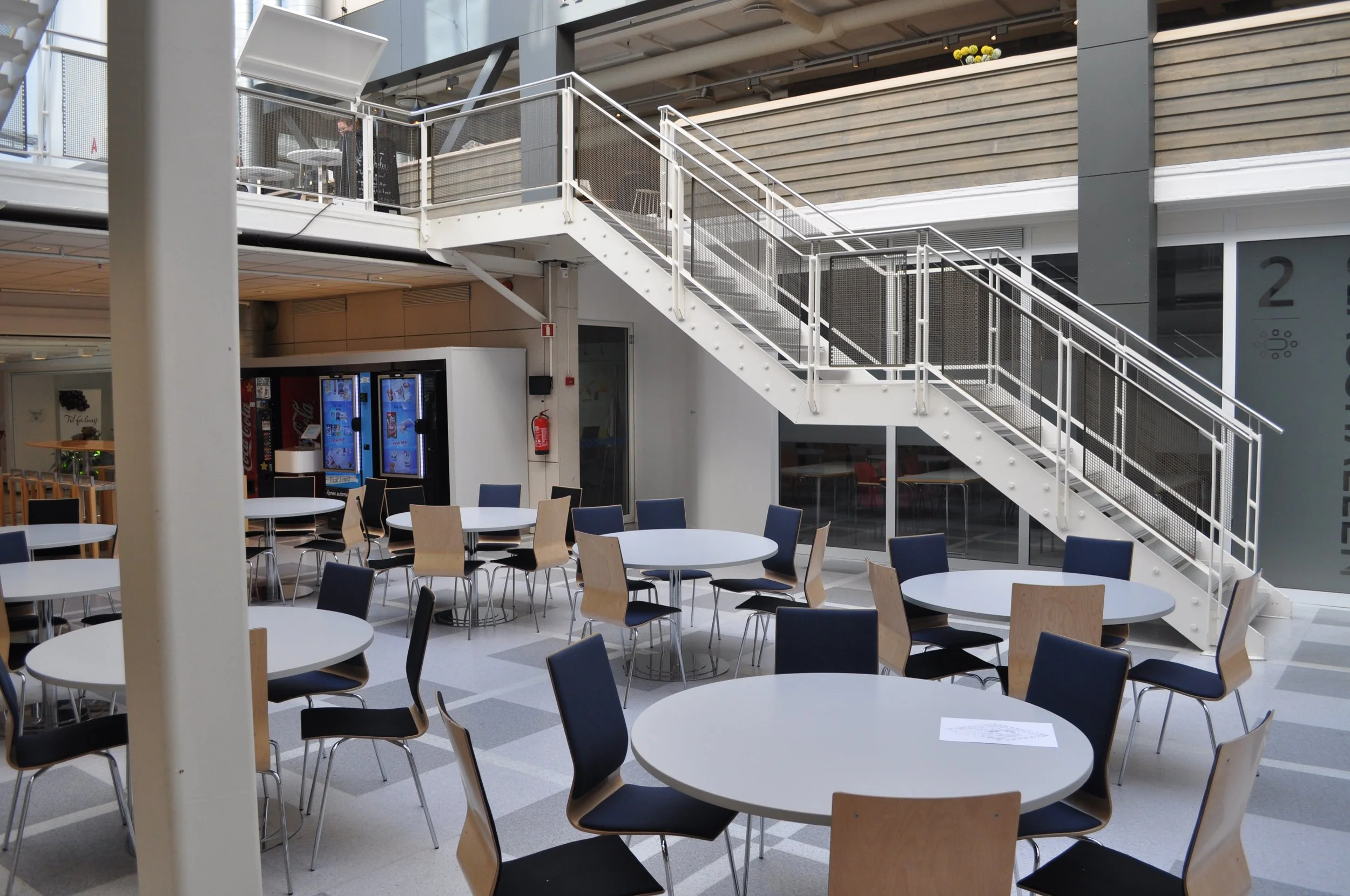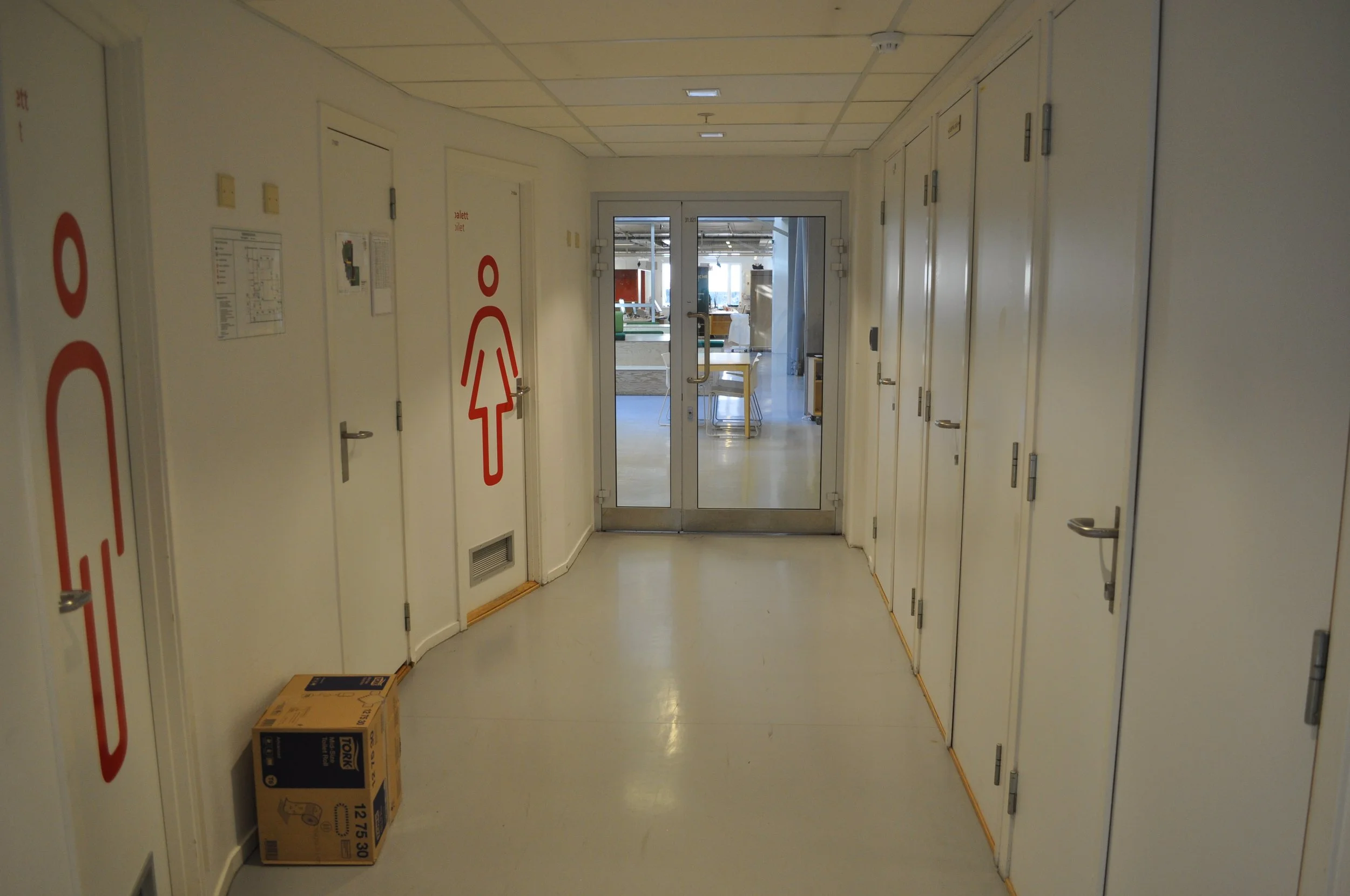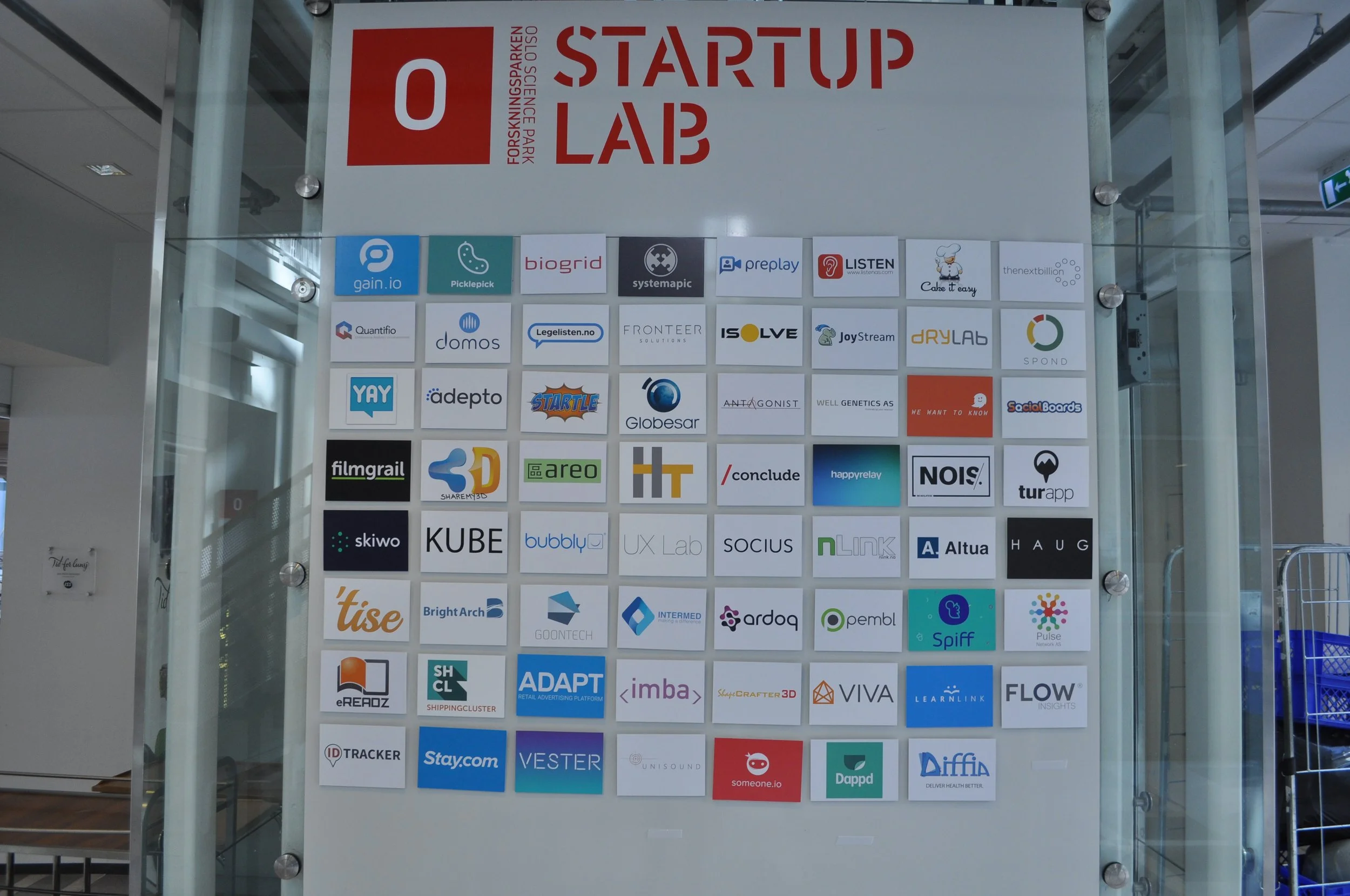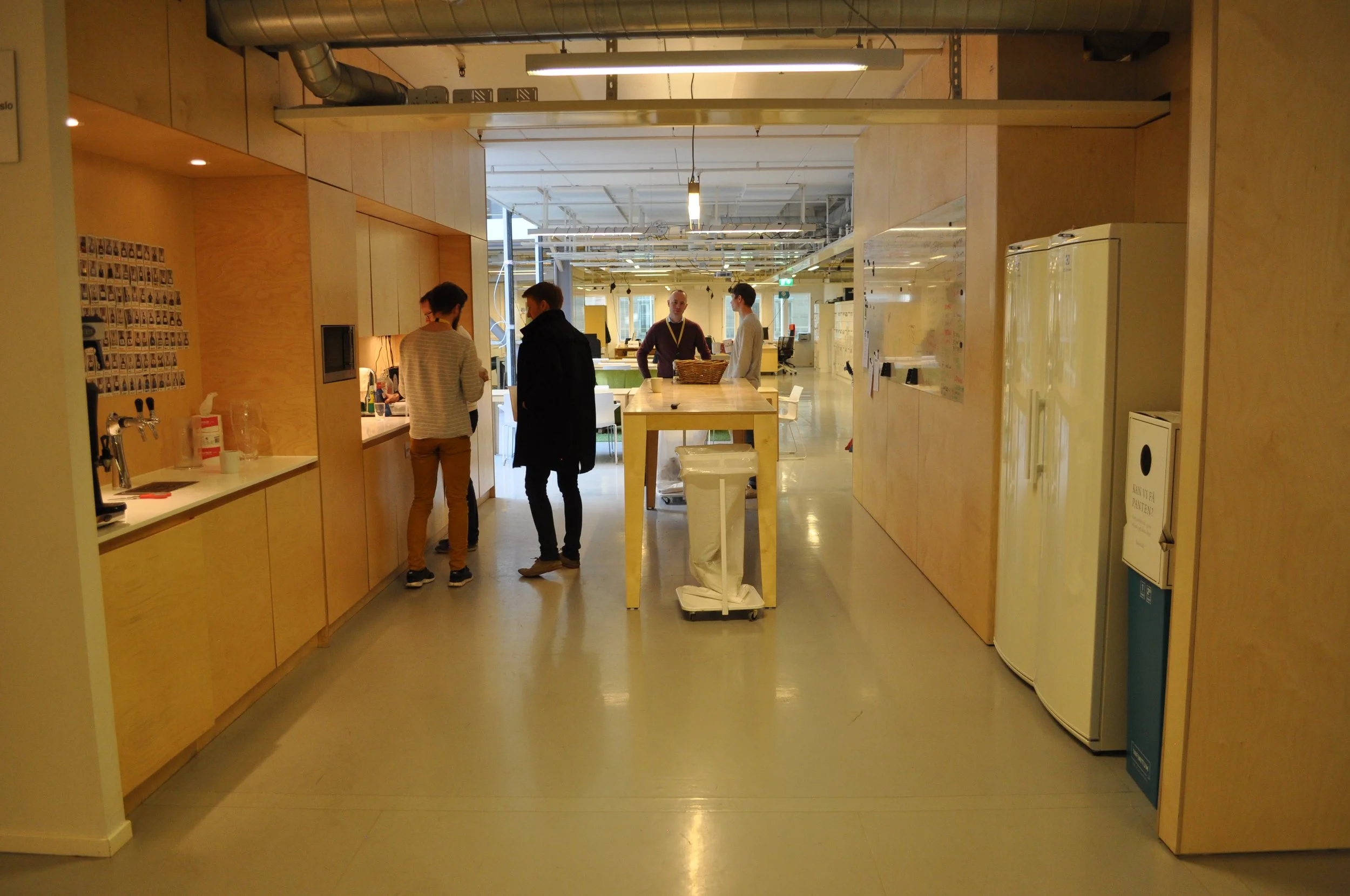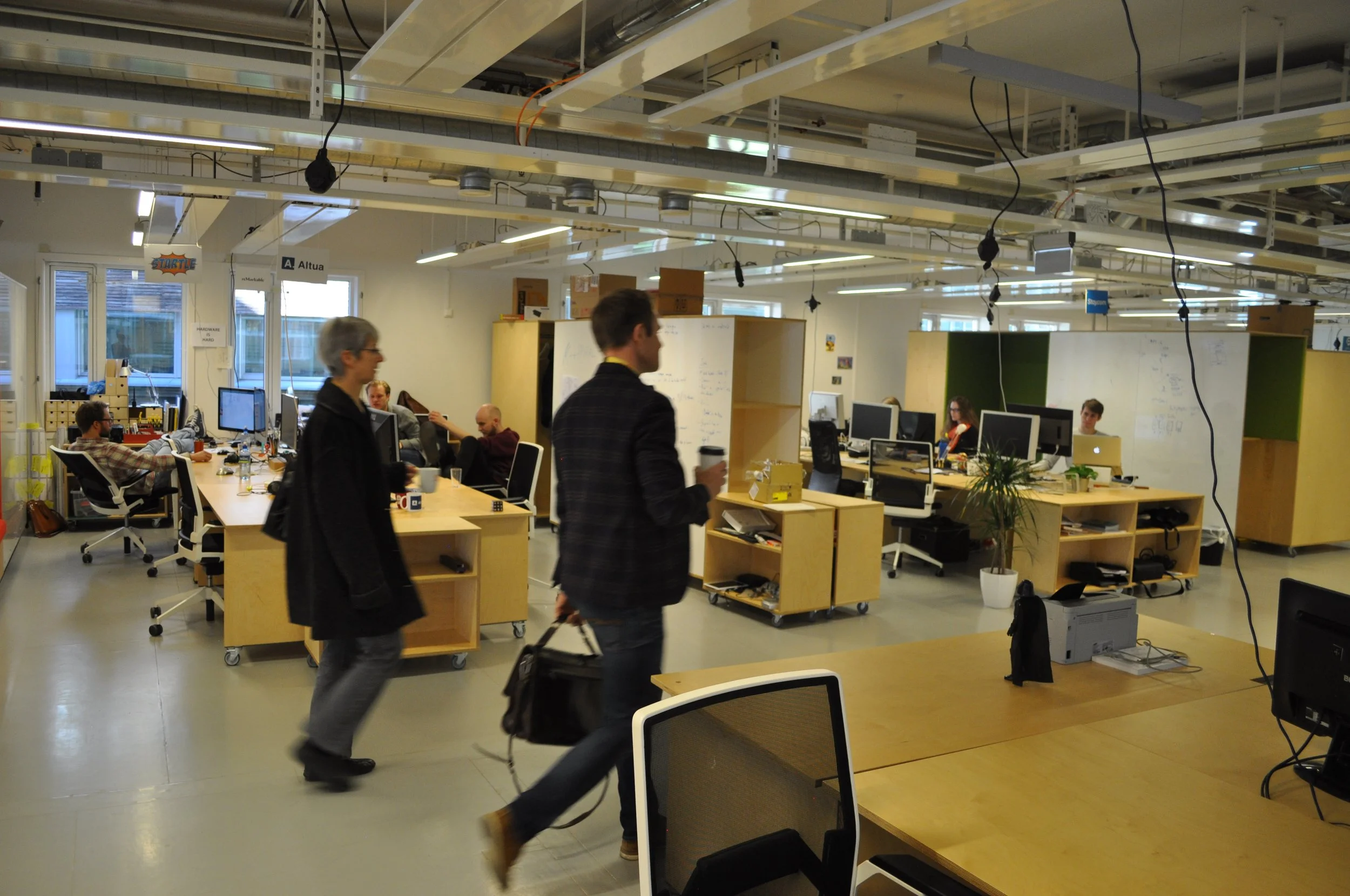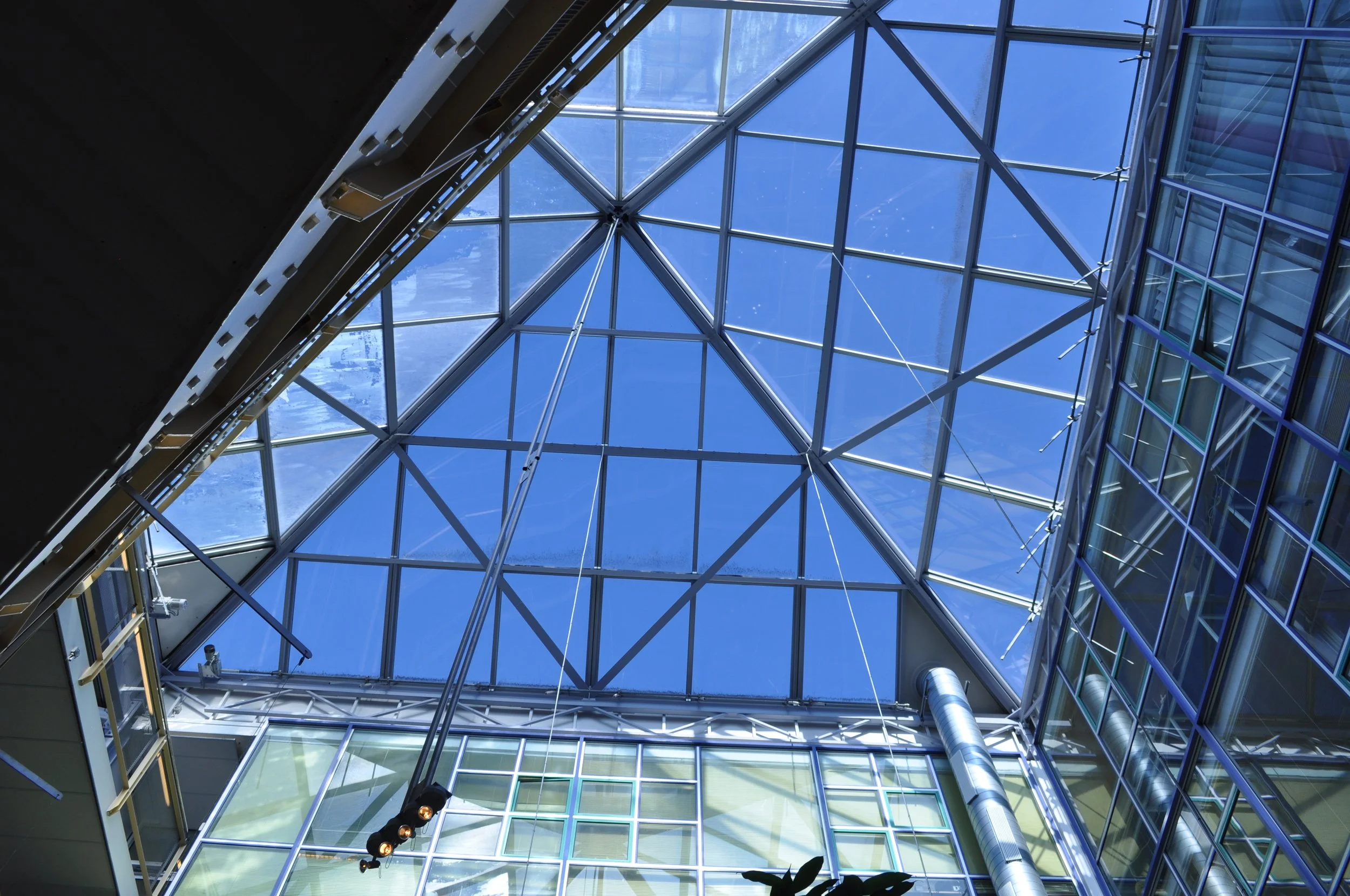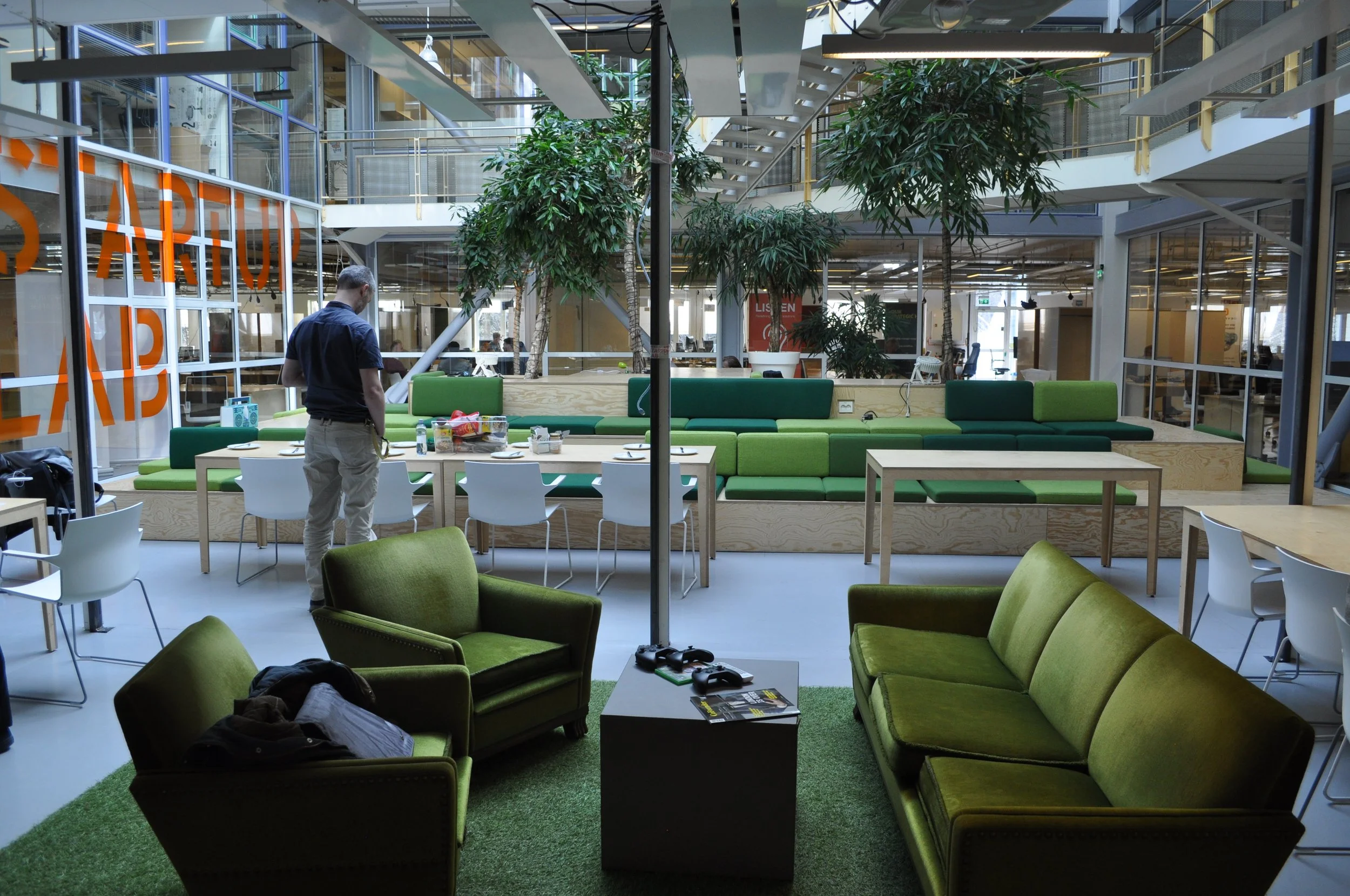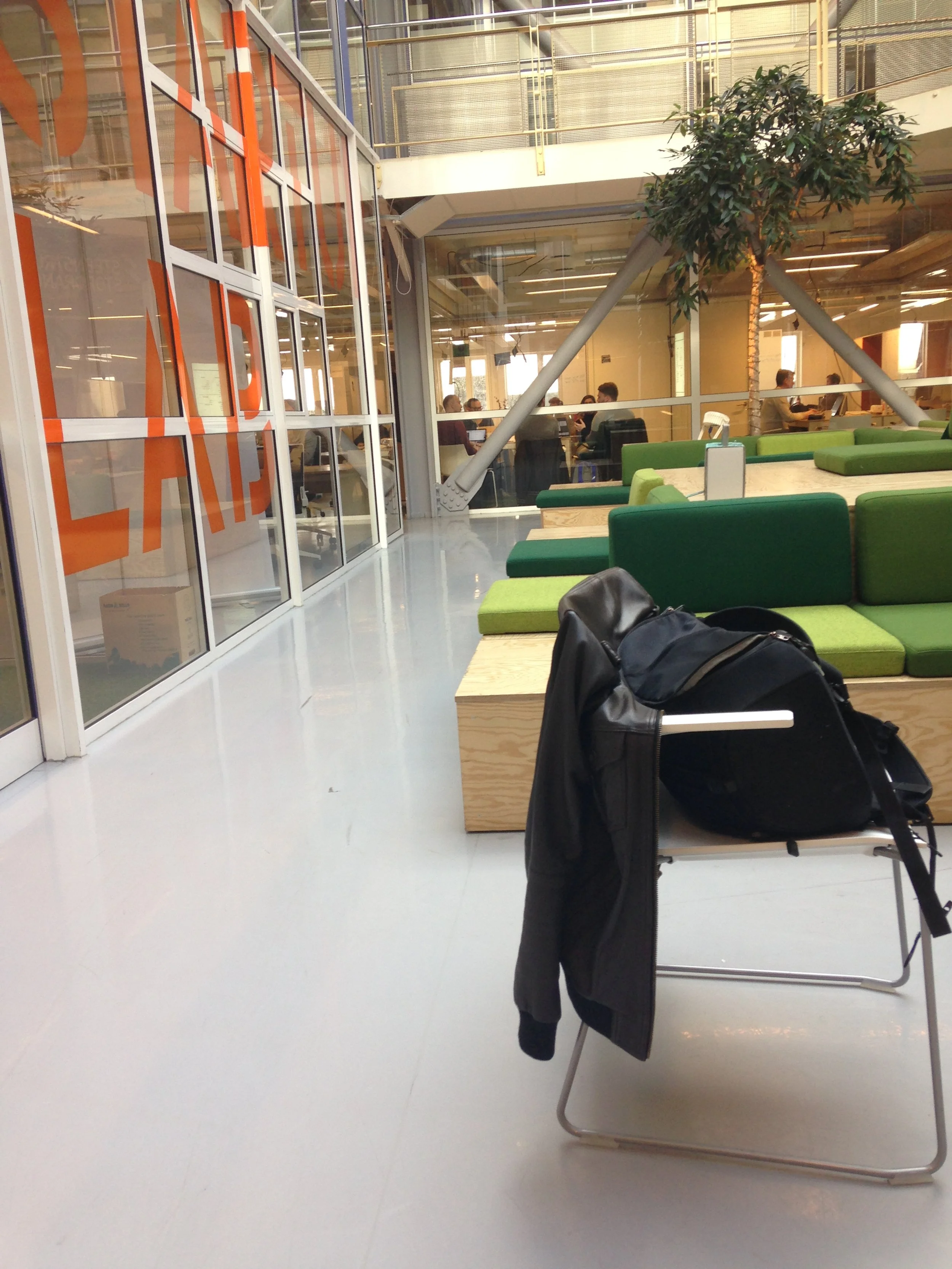Coworking Spaces - from industrial complexes to the fourth industrial revolution?
T Phan
Institute of Urbanism and Landscape, The Oslo School of Architecture and Design (AHO)
Intro. In the summer of 2012 Oslo went from 0 to 4 coworking spaces and in 2016, the number of spaces has more than tripled. This master thesis investigates 3 startup-related coworking spaces (The Simula Garage, StartupLab, MESH) in the Oslo area. What are the spatial culture and urban implications of coworking spaces?
-
Master thesis, spring 2016.
-
Aspelin Ramm Award
Top 30 Super Talents under 35, Kapital Business Journal -
What are the spatial culture and urban implications of coworking spaces?
Sub-questions:
What are the cultural, social and economic factors causing the rise of coworking spaces and in which direction is this development heading in the contemporary society?In the digital age and economy and in regards to the concept of a fourth industrial revolution where everybody virtually can work apart from each other; in what way is local proximity still relevant?
What is the culture of coworking spaces? What are the spatial properties of coworking?
-
1.0 Introduction - Summary, research question and research design.
2.0 Literature Review - Literature and theory discusses the concepts and relation between 21st century industrial complexes and coworking spaces.
3.0 Backdrop & Context - The history of entrepreneurial roots and development in Silicon Valley and Oslo. The history of these two brings up an important discussion; Whether the entrepreneurial and startup-culture are ideological import of global trends or if it in fact is locally rooted in Oslo.
4.0 Case Studies - investigation of 3 Oslo-based and startup-related coworking spaces in the context of cluster, science city, science park and district. The investigation will revolve around aspects such as management, image, profile, criteria for entrance, physical layout, urban implications, working and social culture etc. There will also be a spatial analysis of all these aspects, and a discussion of the future model of coworking spaces.
5.0 Discussions - Bridging the literature review and case studies and concluding the key findings of the notion of community.
6.0 Appendices - bibliography, captions, interviews, public meetings etc. -
Item description
-
ARTICLES
Anttiroiko, Ari-Veikko (2004), Science Cities: Their characteristics and future challenges, International Journal of Technology Management, Vol.28.
Bagwell, Susan (2008), Creative clusters and city growth, Creative Industries Journal, Vol.1, nr.1.
Brattbakk, Ingar & Landsverk, Aina et. al., Hva nå, Tøyen? Sosiokulturell stedsanalyse av Tøyen i Bydel Gamle Oslo, Arbeidsforskningsinstituttet 2015, p. 7-8.
Hurst, Erik & Benjamin Pugsley (2011), What Do Small Businesses Do?, NBER Working Paper No. 17041.
Black, Dan, Gary Gates, Seth Sanders and Lowell Taylor (1998), Why Do Gay Men Live in San Francisco?, General Social Survey.
Bourdieu, Pierre (1993), La Misère du monde, Paris, Seuil.
Gottmann, Jean (1970), Urban centrality and the interweaving of quaternary functions. Ekistics, 29.
Johnstad, Tom (2003), Kunnskapsbyen Oslo – Forskningstriangelet rundt Blindern og Universitet I Oslo, NIBR. Kunnskapsdepartementet, Kommunal- og regionaldepartementet og Nærings- og handelsdepartementet (https://issuu.com/tinphan1989/docs/coworking_spaces_-_onepage, Entreprenørskap i utdanningen – fra grunnskole til høyere utdanning 2009-2014, F-4251 B
Mokyr, Joel (1998), The Second Industrial Revolution, 1870-1914, Northwestern University.
Moriset, Bruno (2013), Building new places of the creative economy. The rise of coworking spaces, HAL.
Porter, Michael (1998), Harvard Business Review, Nov/Dec 98, Vol.76 Issue 6.
Phan, Phillip, Donald Siegel & Mike Wright (2005), Science parks and incubators: observations, synthesis and future research, Journal of Business Venturing 20.
Rognlien, Bruse (2013), IT FORNEBU 2013 – en undersøkelse av et omstridt utviklingsprosjekt mot slutten av den forventede realiseringstiden, Norwegian University of Life Sciences.
Quinn, J.B., J.J. Baruch & K.A. Zien (1996), Software-based innovation, Sloan Management Review.
Schwab, Klaus (2016), The Fourth Industrial Revolution: what it means, how to respond, Foreign Affairs
BOOKS
Castells, Manuel & Hall, Peter (1994), Technopoles of the World - The making of 21st Century Industrial Complexes, Routledge.
Benneworth, Paul, Julie Tian Miao & Nicholas A. Phelps (2015), Making 21st Century Knowledge Complexes – Technopoles of the world revisited (Regions and Cities), Routledge.
Florida, Richard (2002), Rise of the Creative Class, Basic Books.
Miles, Malcolm (2007), Cities and Cultures, Routledge.
Moorhouse, Geoffrey (1979), San Francisco, TIME-LIFE Books.
Oldenburg, Ray (1989), The Great Good Place, New York, Paragon House.
Reve, Torger and Sasson, Amir (2012), Et kunnskapsrikt Norge, Universitetsforlaget.
Roszak, Theodore (1986), From Satori to Silicon Valley, Don't Call it Frico Press.
Roszak, Theodore (1969), The Making of a Counter Culture, Doubleday & Company.
Sassen, Saskia (2000) The Global City, New York, London, Tokyo, 2nd edition, Princeton, Princeton University Press.
Turner, Fred (2006), From Counter Culture to Cyber Culture, University of Chicago Press. -
Aftenposten (11.03.16)
Aftenposten 2 (15.03.16)
Aftenposten 3 (11.03.16)
Aftenposten 4 (18.05.16)
Digi (07.03.16)
European History (09.03.16)
First Industrial revolution, The (10.03.16)
Guardian, The (04.05.16)
Guardian 2, The (24.03.16)
New York Times (14.03.16)
NRK (08.03.16)
Regjeringen (30.03.16)
Shaughnessy (28.03.16)
Simula (22.04.16)
Simula 2 (25.04.16)
Store Norske Leksikon (07.03.16)
Teknisk Ukeblad (15.05.16)
Time Magazine (28.03.16)
Steegle (05.05.16)
Teknisk Ukeblad (17.05.16)
Teknisk Ukeblad II
TV Vest (14.03.16)
University of Virginia (05.05.16)
Utdanningsdirektoratet læreplankode ENT1-01 (08.03.16)
Washington Post (14.03.16)
Wadhwa (26.03.16)
WEF (06.05.16)
Wikipedia (12.03.16)
Wikipedia 2 (04.05.16)
Wikipedia 3 (04.05.16)
Wikipedia 4 (04.05.16) -
Summary
According to Oslo Business Region’s estimates, startup-related coworking may take up to as 40% of the employment rates in Oslo in near future, where the percentage is currently on 2. If freelance work are occupying more and more of the working society, so will the definition of what a workspace might be. While this new trend is emerging, another ancient tradition is endangered - namely serendipity, or incidental but favorable events at work; such as small talk over a cup of coffee, knowledge exchange, and room for unforeseen results and ideas at the workplace. If companies and corporations no longer hire competence and expertise in-house, but rather outsource it to freelancers; how will this production of beneficial coincidences at the workplace occur among knowledge workers? It is here coworking spaces emerges as an enduring necessity; in a society where everybody can work apart and every individual is a competitor, participants of coworking are working together, but independently, exploring notions of what a contemporary, yet professional community might be.
Through 3 case studies, this thesis elaborates on the properties that defines and distinguishes each of them from a set of categories such as: history, management, image and profile, physical layout, urban implications, working culture and social culture. The quality and success of these spaces are not only measured by pure architectonic, urban qualities or economic measures, but also a mixture of intent, virtues, business segment, a critical mass of intellectual property etc.
Looking past the exotic nature and hype around coworking spaces, resides something more than just a mere trend; they embody the quintessence of the next generation workplaces; a powerhouse of serendipity production in a world getting increasingly more fragmented. Therefore, a workplace here is not just a mere desk and place to work, but an experience in itself. The practice of a careful selection of members is essential in order to cultivate specific communities. We have to ask how the mobilization of knowledge workers through clever subleasing systems are becoming the vanguard of our contemporary working ideals. In the field of urban planning, coworking spaces may in fact evoke some interesting questions in its transcendent values; of how working societies can be replicated in neighborhoods and districts.
Concluding remarks
Excerpt from ch. 5., p. 143-144. The coworking concept itself may fade away and maybe startup-related coworking/startup communities go into obscurity, yet, I argue here that it is this culture of community which make aspects of coworking transcendent and stand the test of time. Although the phenomenon was comprehensively described only as late as 2013 by Moriset, informing on the genesis and formative years of coworking, it has since grown to become a complex space of both cultural and urban character. As mentioned earlier, according to Oslo Business Region’s estimates, startup-related coworking may take up to as 40% of the employment in Oslo in near future where the percentage is currently on 2. Coworking may not only become the norm of workplaces, but also generate unprecedented variations of what a professional or social community can be. The upcoming years may in fact reveal coworking spaces in its adolescent years, generating the most interesting data on collective ideology and the planning of communities, which have the potential to be translated into architectural and urban development. They should be monitored, studied and researched upon to understand what direction the next generation of workspaces and societies may take. We have to speculate from the very modest beginnings of the lone eagles rounding up tables in a shared facility, to what role and impact they may have on society.
